
This Everest Base Camp trek guide shows how the Nepal EBC journey isn’t a light-hearted adventure. It’s a mini-expedition that will test and reward you.
It was the eighth final day of the ascent on the trek to Everest Base Camp. The 6 am wake-up call marked the start of our eighth day of trekking in this sacred area of Nepal, where the swift knock on the door and long-resounding tones of “morning” signalled the start of another long and arduous day. By this point, each day of the EBC expedition began to feel like a relentless and monotonous struggle.
Except this was the day where, despite extreme exhaustion, weakness from loss of appetite and braving bitterly cold conditions, we all hoped to find enough energy to pull ourselves through the last leg of our journey to get to Everest Base Camp. A journey to trek to the highest mountain in the world and stand at its foundation upon the jagged Khumbu Glacier.
I didn’t feel giddy with excitement that morning. Instead, swathed in five layers of clothing and still suffering from severe coughing and altitude headaches, I felt relieved that what I had set out to achieve was just a few hours away. I just wanted the pain to go away. Even the strongest of people were flagging.
We pulled ourselves slowly and sluggishly through the thin and icy air over six hours, broken up halfway by a short break at our accommodation tea house. I remember one of the Sherpas grabbing my arm to hold me up, pulling me over rocks and icy pockets as my legs were about to give way and pushing me to the end because I refused to be defeated. Not now, so close to the dream of climbing Everest Base Camp.
When we reached the top of the final climb, stumbling over loose rocks and onto a canvas of white, I could only sit and cry at what had become one of my greatest achievements.
The top of the world was standing right before me.
Everest Base Camp Trek Guide – All Questions Answered
Everest trekking is a dream of any avid adventurer, but just because you are not climbing Mount Everest, do not think the hike to Everest Base Camp (EBC) is easy. It’s so tough that, at times, you question your sanity and why you ever decided to do it.
At other times, you look at the scenery that’s so breathtakingly stunning and unlike any mountainous terrain that you have ever seen before – changing from lush green farmland, dense forest and glistening blue fast-flowing rivers to the barren land and glacial pools the higher you climb – that you realise it was a good decision. Here you are, backpacking Everest like a warrior. They call it the “steps to heaven” for a good reason.
It’s one of the hardest physical and mental challenges I have ever faced in my life. Yet, it became one of my proudest moments upon reaching Base Camp and looking up towards the clouds wrapping the top of Everest.
And that’s just a snippet of your feelings whilst ON the trek. A dozen questions run through your head before booking this adventure, so here are the answers to the most posed questions about how to hike to Everest Base Camp.
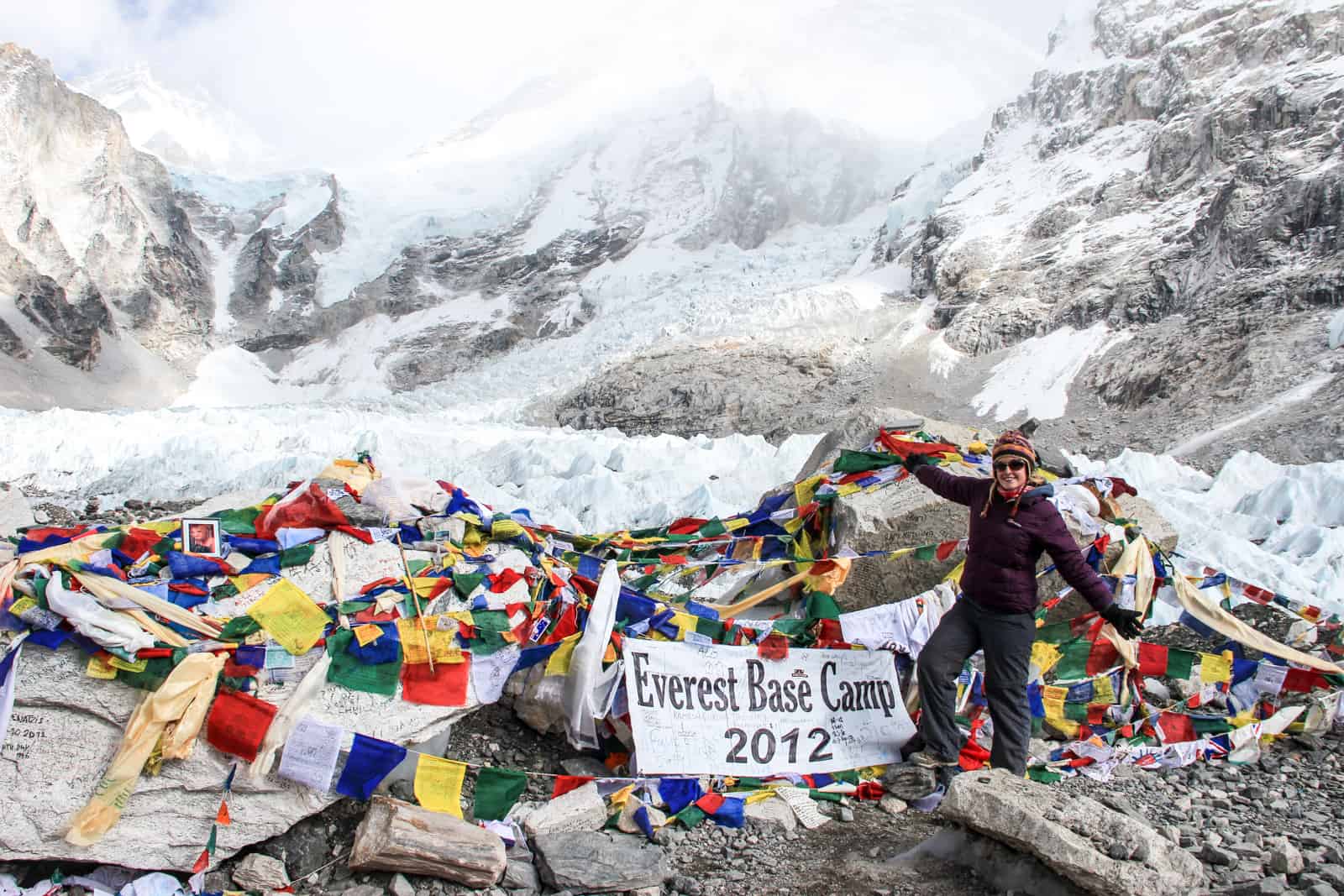
Everest Base Camp Trek Guide – Facing The Challenge. Reaching the Top of The World.
How Long is the Trek to Everest Base Camp?
The trek to Everest Base Camp typically takes 12 days to complete on a 130km round-trip. It takes eight days to get to Base Camp and four days to get back down, broken down into nine days of long trekking and three short trekking acclimatisation days.
Any treks which claim (or push you to complete the trek in a shorter amount of time) do so at risk. Despite the relatively short distance overall, there is a reason the journey to EBC camp one is stretched over 12 days, mainly due to the steep rise of altitude.
Nepal Everest Base Camp Trekking Route
There is a set route for EBC trekking that takes you through various villages, camping grounds and incredibly isolated spots with magnificent views of the mountain panoramas.
- Way up: Kathmandu – Lukla – Phakding – Namche Bazaar – Tengboche – Dingboche – Lobuche – Gorak Shep – EBC
- Way down: Gorek Shep – Pheriche – Tengboche – Monjo – Lukla – Kathmandu
Day 1: Kathmandu to Lukla flight. Trek to Phakding
Day 2: Phakding to Namche Bazaar
Day 3: Namche Bazaar acclimatisation day (trek to Thame and Khumjung, the green village)
Day 4: Namche Bazaar to Tengboche
Day 5: Tengboche to Dingboche
Day 6: Dingboche acclimatisation day (hike to Chhukung or Nagarzhang Peak)
Day 7: Dingboche to Lobuche
Day 8: Reach Everest Base Camp, crossing the Changri Glacier, and return to Gorak Shep.
Day 9: Gorak Shep to Pheriche (optional morning trek to Kala Pattar for sunrise views of Everest)
Day 10: Pheriche to Tengboche
Day 11: Tengboche to Monjo village
Day 12: Monjo to Lukla and stay overnight. Flight back to Kathmandu the following day
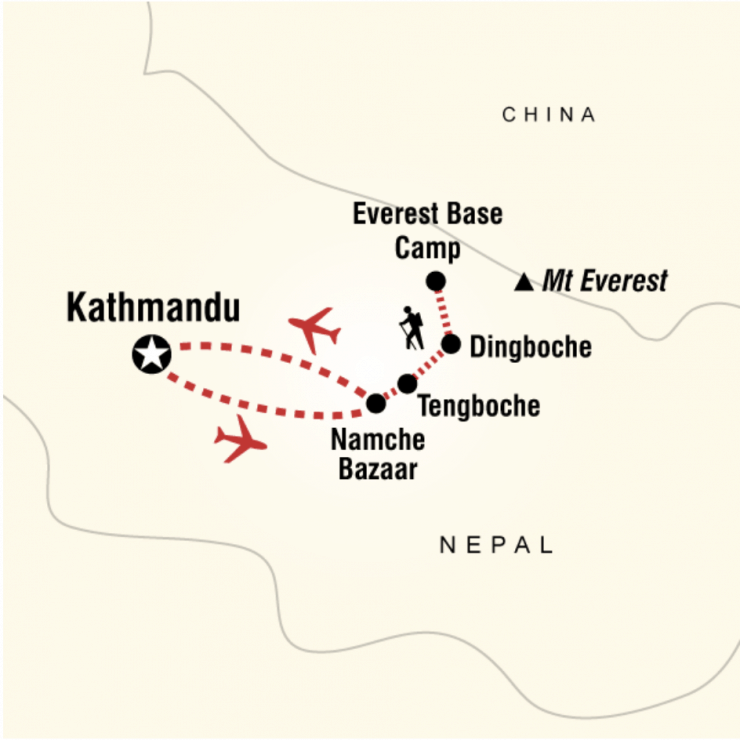
A map of the Everest Base Camp trekking route
Is the Everest Base Camp Trek Difficult?
Trekking from the starting point at 2,850m / 9,000 ft and climbing to 5,364m/ 17,500 ft is not easy, and it is more arduous than technically difficult. You don’t need any particular mountaineering skills or equipment such as ropes and crampons, just a lot of stamina.
Remember, you are not hiking Mount Everest – a feat that can take at least 40 days!
The greatest difficulty you will face trekking in Nepal is with altitude.
The distance from Lukla to Base Camp can be completed more quickly. However, you must stay healthy with less oxygen at a higher altitude. This makes the 12-day trek long – so that you can adjust and allow for acclimatisation as you get higher. It’s tough in parts, especially on the knees, with the daily differing uphill climbs and downhill descents.
I saw people of all ages, all sizes, and varying levels of hiking ability. I’d been that typical asthma kid at school – that one who was told I didn’t have to partake in the difficult athletic endeavours because it was obvious I would never make it. Any attempt would result in some hideous outcome of extreme embarrassment. I did not take much interest in sports or thought I couldn’t do much extreme physical exertion. It took many years to realise that this is not the case, and the Everest Base Camp trek was one of those things I had to do to prove that to myself. If someone like me with a chronic disease can complete the Everest Base Camp trip, so can you.
Besides ALWAYS drinking plenty of water, the most important thing is to go at your own pace. There is also no pressure to keep the same pace as everyone around you. A guide will either be with you, or not far behind a small group of people, so there is no danger of getting lost or alone on the trails.
Is the Trek to Everest Base Camp Dangerous?
40,000 people per year trek to Everest Base Camp on its south side in Nepal. While it remains one of the most popular and well-versed treks in the Himalayas, it’s natural to consider how dangerous this high-altitude endeavour is.
Regarding the terrain, you will not be undertaking any form of wall climbing, walking along narrow ridges with steep drops or using ropes to haul yourself over rock faces. Getting to Everest Base Camp is a slow and steady walk with a strategically timed ascent into altitude.
Extreme thoughts may move to the question: has anyone has died trekking to Everest Base Camp? The fact remains that while there are no official figures, any statistics reported have been less than .5% of the overall trekking number and usually because of a natural disaster. The only danger to you will be if you don’t listen to the advice of your guide or wander off alone.
What is the Best Time of Year to Trek to Everest Base Camp?
The best time to trek to Everest Base Camp falls into two seasons: March to May (spring) and September to November (autumn).
These two trekking seasons fall on either side of the summer monsoon season, allowing for optimal conditions – less rainfall, comfortable temperatures and clearer skies. The heavy rainfall from June to early September renders the Everest Base Camp trail off-limits. It becomes treacherous territory with muddy, inaccessible paths and risk of landslides.
The March to May trekking season has the advantage of warm, sunny days and the opportunity to see the bustle of those setting up camp at Base Camp, ready to climb Everest. The disadvantage is the chance of humidity and heat on the long trek and cloudy weather in May as the monsoon season brews.
The September to November trekking season has the advantage of crisp, clear skies allowing incredible views of the Himalaya ranges. A trade-off for the more moderate temperatures, which get colder towards November, especially at night. As my pictures show, visibility in November was glorious.
How cold is it at Everest Base Camp?
While the first few days of trekking in the low Himalayan forest are in warm and slightly moderate temperatures, the second half takes you right into the mountain plateau’s cooler and often freezing altitudes.
On Base Camp itself, temperatures can vary from 1 to -10 degrees, on average. Be prepared with base layers, mid-layers and a down jacket – the morning trek can also be a slog in icy winds, so you’ll want to be as comfortable as possible.
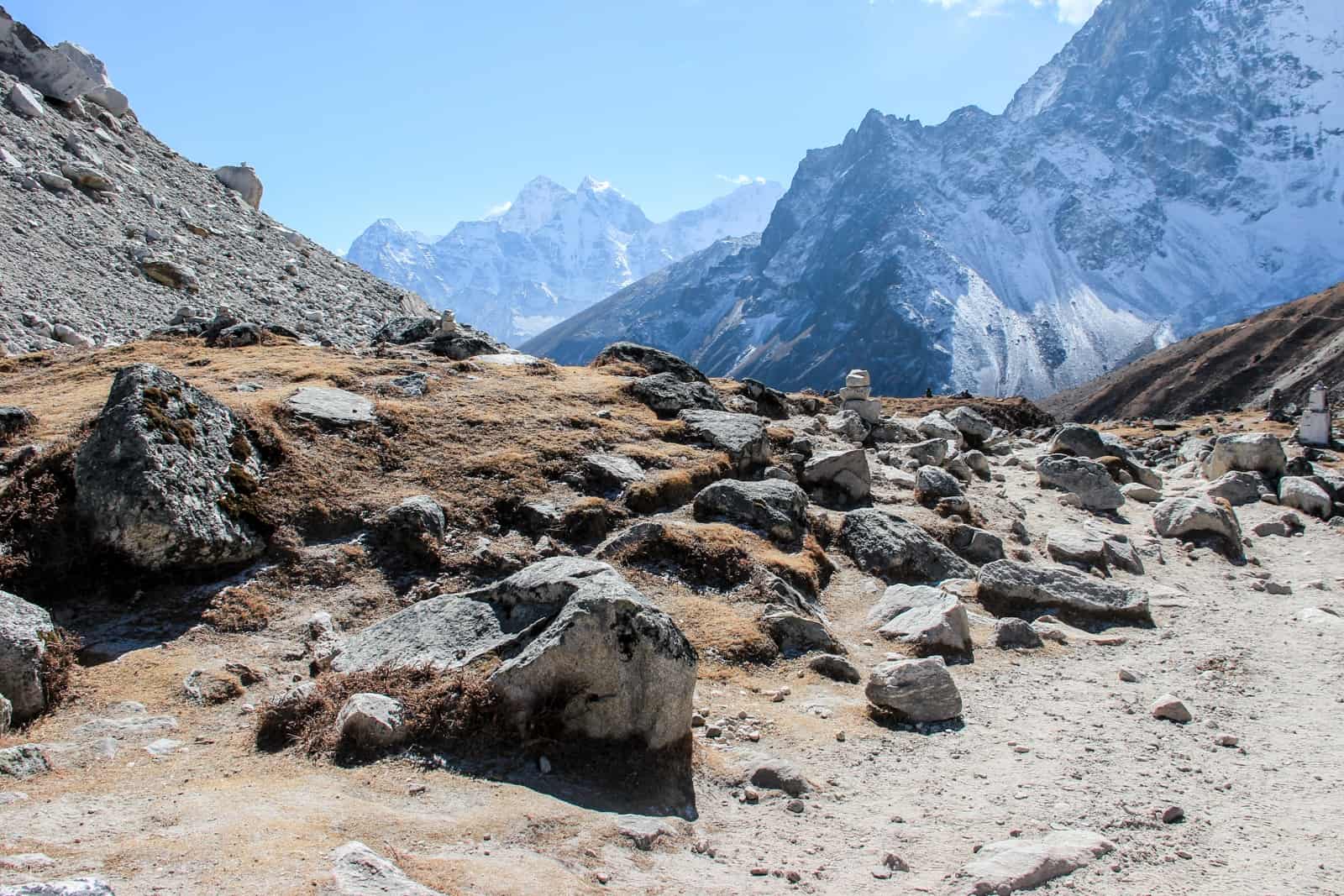
Do I Need to Train for Everest Base Camp?
Strength and endurance are the core aspects of your fitness that will help you build up for EBC success. Doing short practice hikes at home at least two to three months before you leave is recommended. Start with some two to three-hour hikes on varying ascents and descents, and try to build up to a five or six-hour hike to get used to long hours at a similar pace. This will give you a better idea of an average day of trekking EBC.
If you are already on the road before the trek, like I was, factor in some hikes in the destination you are in. I went to many mountainous areas of China three months before my EBC trip, where I did half-day treks and multi-stair climbs.
One woman on my trip undertook altitude training at a test centre at home, and while this expensive training measure helped a little, she was still hit with altitude sickness on the Base Camp trek. You can’t control nature – just get yourself in the best shape possible before arriving.
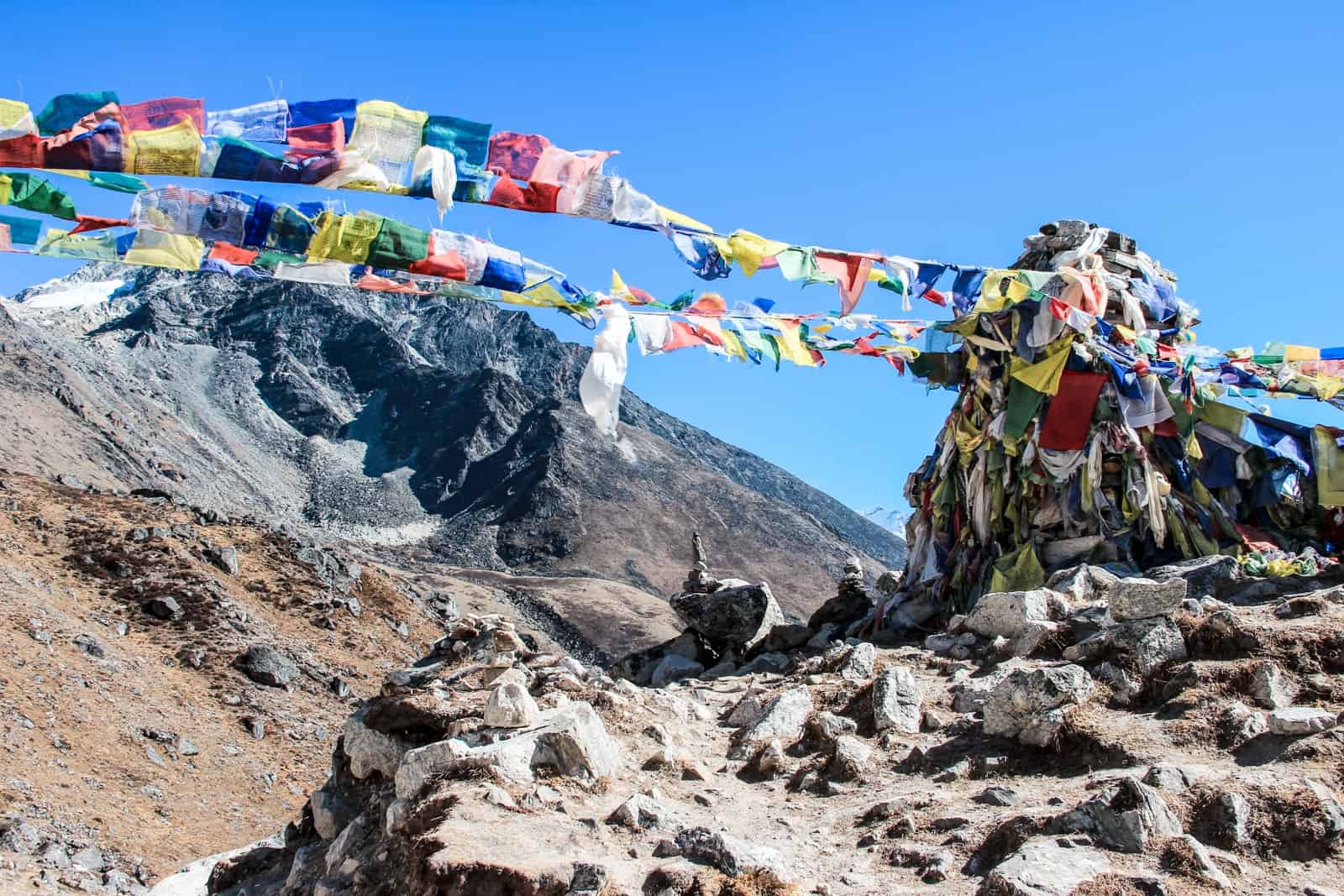
Everest Base Camp Tours – Trek in a Group or Solo?
I didn’t know what to expect from the epic Everest Base Camp trek. I knew it would be hard, but I never realised how hard it was. The most I had managed before this was a three-day jungle hike in Northern Thailand, which now feels like a walk in the park.
Can I do the Everest Base Camp Trek Alone?
With the streams of websites on top of the dozens of locally offered tour offerings when you arrive, it’s hard to know where to start when booking a trip to hike Mount Everest. I toyed with the idea of hiring a guide when I was there but figured being on my own might be lonely when you need the camaraderie of others to spur you on. I was also close to using localised websites for Everest tours, such as Bookmundi, to meet others, form a group and hire guides and porters. Still, I worried that I would be thrown into the midst of diehard trekkers, where I would be a burden or unable to keep up.
There have also been multiple reports of people trekking solo, even without a porter or a guide and going missing. Do not underestimate the power of nature, and not knowing your surroundings. Everest trekking in Nepal may be a big business, but it’s not something to be stubborn about. This isn’t a place to get lost as it’s hard to be found. The porters and guides are born and bred here and understand the terrain and the changes in altitude. If you want a solo experience, hire a local guide to ensure you do so in the safest environment possible.
Small Adventure Group Tours to Everest Base Camp
I booked the 12 day Everest Base Camp trek with G Adventures over six months before I was due to start it, ensuring that I would be with a group. It is an organised Kathmandu to Everest Base Camp tour, with plenty of time in the city on either side.
And so I began my EBC trip with 14 people, alongside two guides and four porters. Looking back, I needed a lot of those people. I relied on them when times got tough because this isn’t just a test of physical strength but one that pushes you to the limit mentally, too. A simple hug and daily words of encouragement made everything better. When you cried, they understood or cried too because we were all going through the same pain. The laughter and the nights huddled around the fire, talking and getting to know one another better, overshadowed any negative thoughts that were always lurking.
I doubt I would have completed this trek without the collective morale between us.
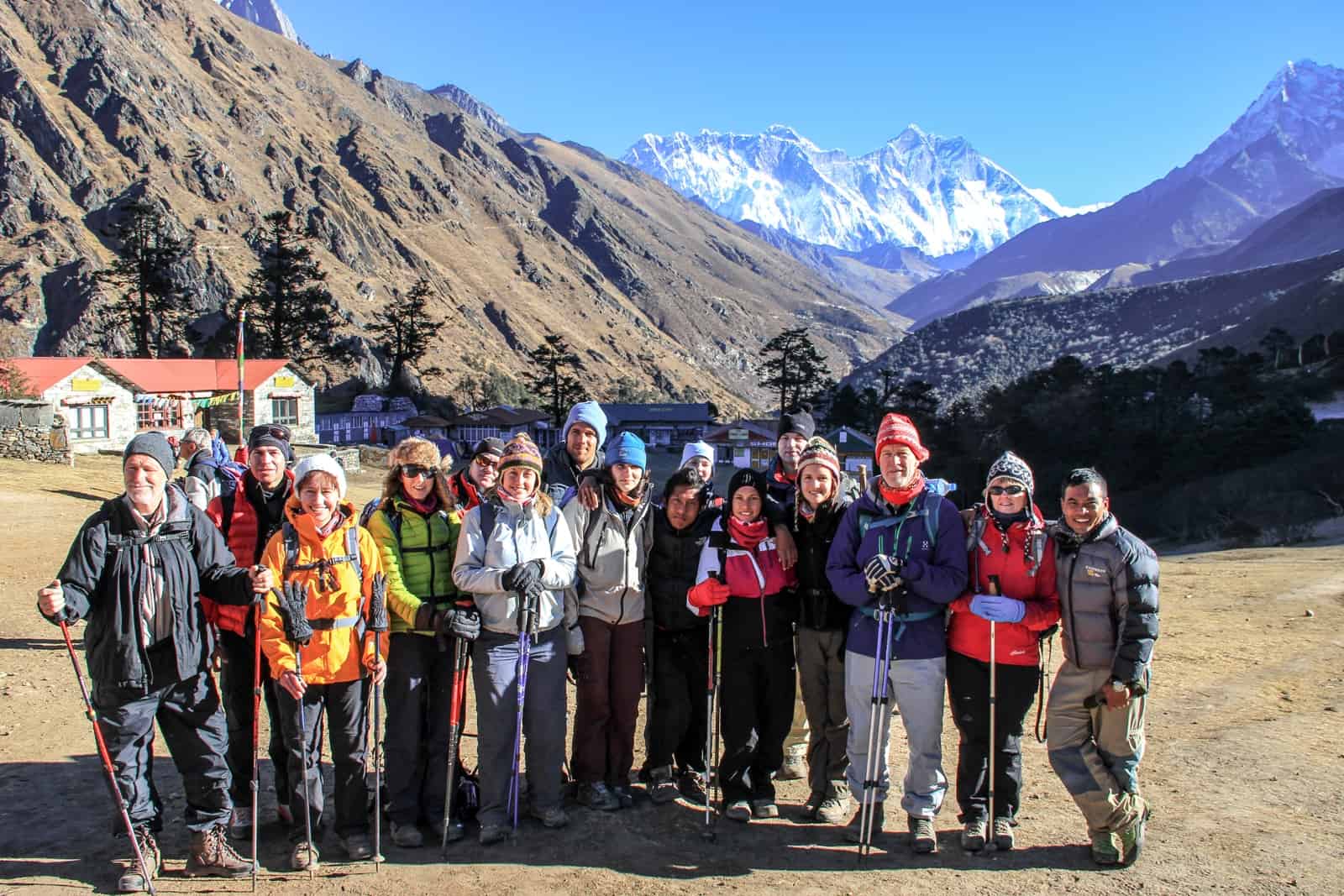
My EBC Trek group and guide
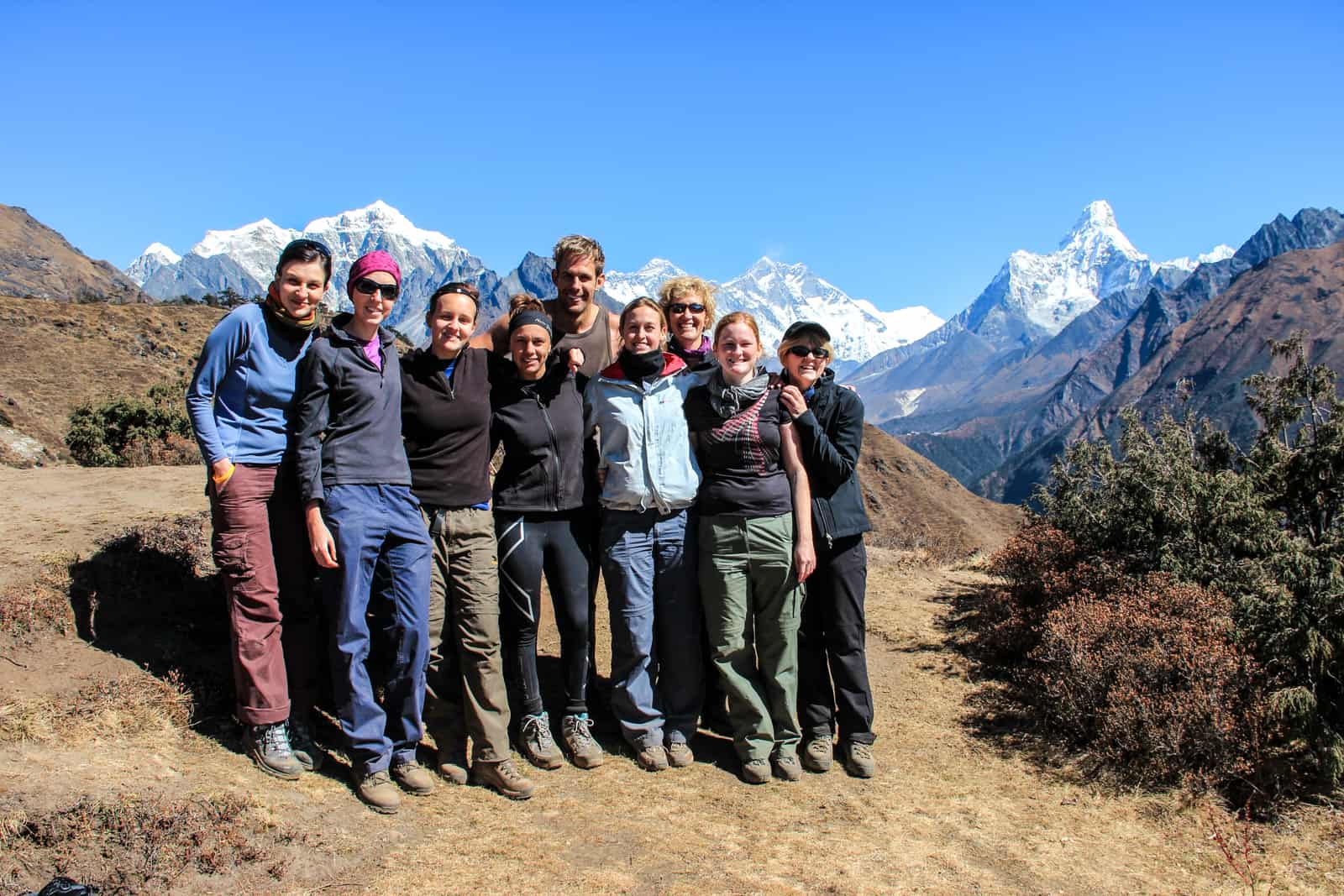
Treks are better when you are together.
How much Does it cost to do the Everest Base Camp Trek?
I’ve seen the Everest Base camp trek cost starting from $1,200 up to $1,600, but it helps to know what’s included and the ethics of the company, including how they support their porters and other local staff and resources.
Usually, what is included in the trek cost of Everest Base Camp is:
- At least one night of accommodation in Kathmandu on either side of the trek
- Return flight to Lukla from Kathmandu
- Accommodation for the entire trek (typical teahouses in Nepal)
- A licensed and trained trekking guide
- Porters for carrying your larger bags and supplies for the trek
- Permits for trekking and the National Park/Conservation Area entry permit
The main variable that differs from company to company is the inclusion of all meals and beverages at the trekking camps and EBC teahouses while trekking.
Some treks are cheaper because food and drink are not included, and you can set aside a personal budget for this.
What’s NOT included in the trek cost:
- Travel insurance, which you must arrange yourself and ensure it includes emergency rescue
- International flights/airfare
- Visa costs for Nepal and the organisation of the trek
- Rental of equipment like a sleeping bag or down jacket (you can do this in Kathmandu before the trek)
- General trekking gear, such as walking poles
- Snacks
- Medication (including altitude sickness tablets)
Everest Base Camp Trekking Permits
There are two permits required to trek the Everest Base Camp trail.
- The Khumbu Pasang Lhamu Rural Municipality Entrance Permit replaced the old Trekkers Information Management System (TIMS) permit in October 2018. It costs NPR 2000 Per Person and is obtained in Lukla.
- The Sagarmatha National Park Entry Permit is needed since you will trek through the park. It costs NPR 3000 Per Person.
However, on most organised small group trips, these permits are managed by your guide and included in your overall tour cost. It’s worthwhile to check if they are included.
Can I Visit Tibet Everest Base Camp?
I have also visited Tibet Everest Base Camp on a countrywide overland tour. On a separate trip, you can travel to Tibet on a two-week adventure (on a round trip from Kathmandu), which passes through the Tibetan region of Rombuk.
Visiting Base Camp on the Tibetan side isn’t a multi-day hike though, but more of a long walk to the Base Camp boundaries from the Monastery in Rombuk where you stay overnight. Everest Base Camp on the Tibet side has recently been moved back by 7km, making the proximity to Everest mountain even less attainable, yet nothing beats the flipside view of it.
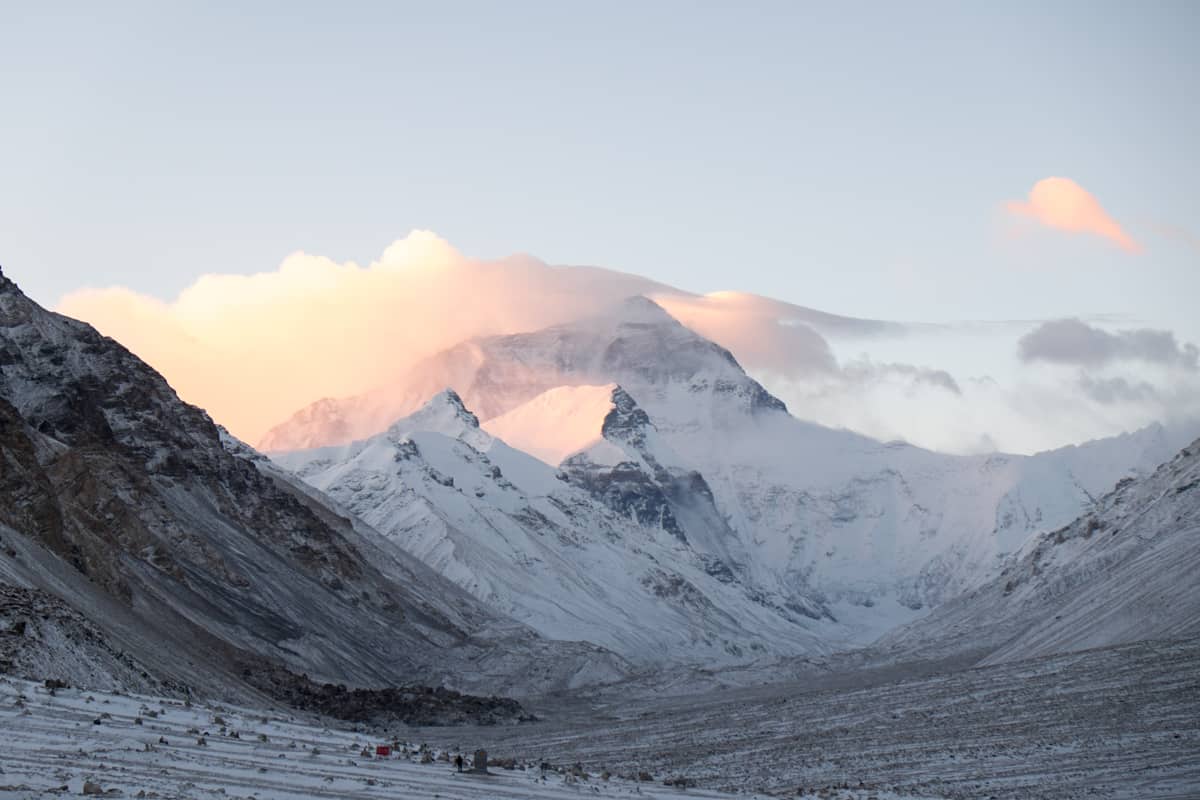
Tibet Everest Base Camp
Day-To-Day Trekking Guide
Everest Base Camp Trek Itinerary: Day One
Leaving Kathmandu, you’ll brave an early morning flight to Lukla – a small aircraft where the engine roars for 40 minutes (muffled in vain by the complimentary cotton wool from the flight attendant that you’re urged to stuff into your ears). The wind lightly wobbles you in the air until you touch down on the famous short, steep and precarious mountain-side runway that Lukla is known for.
The Lukla flight is included in your EBC trip itinerary.
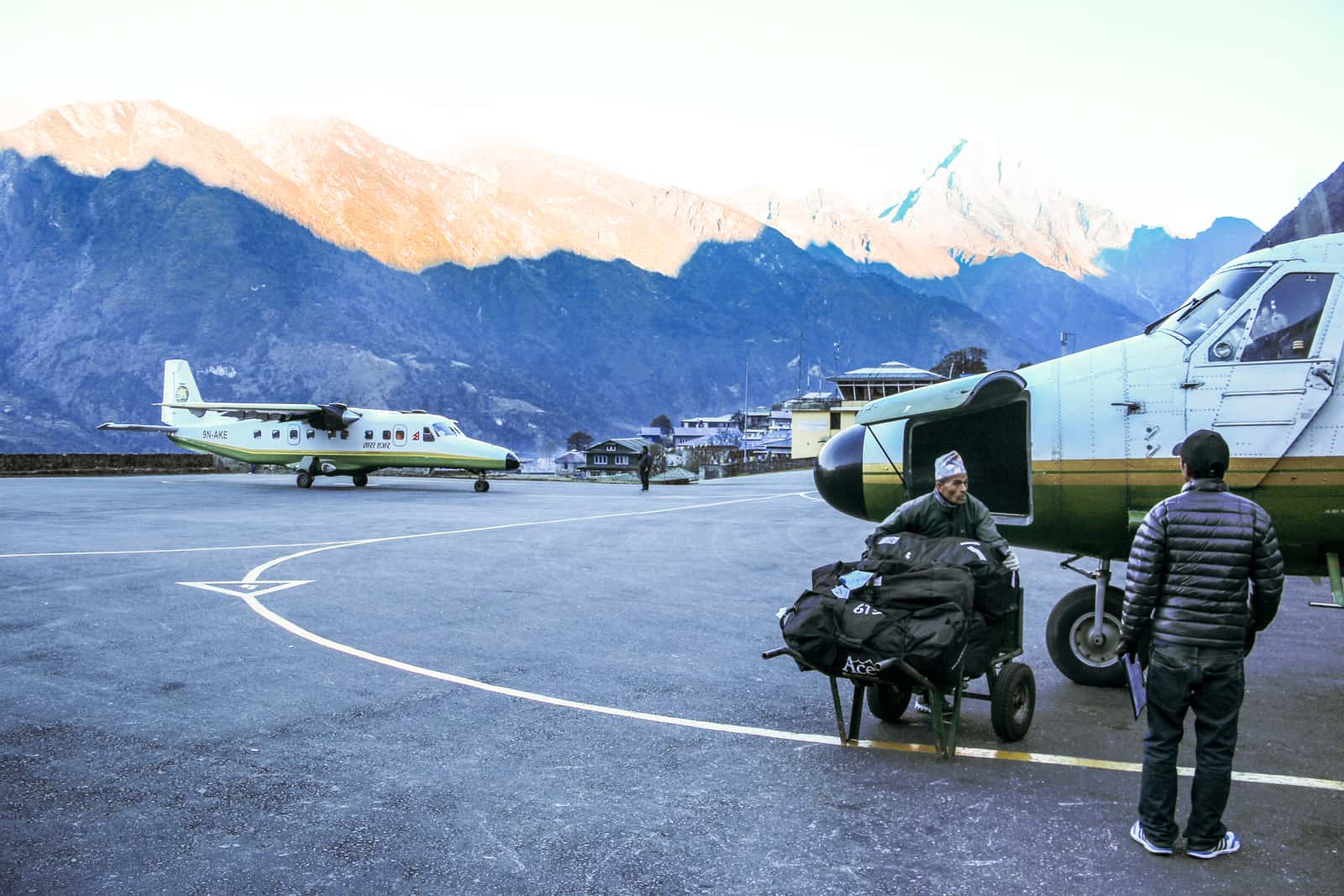
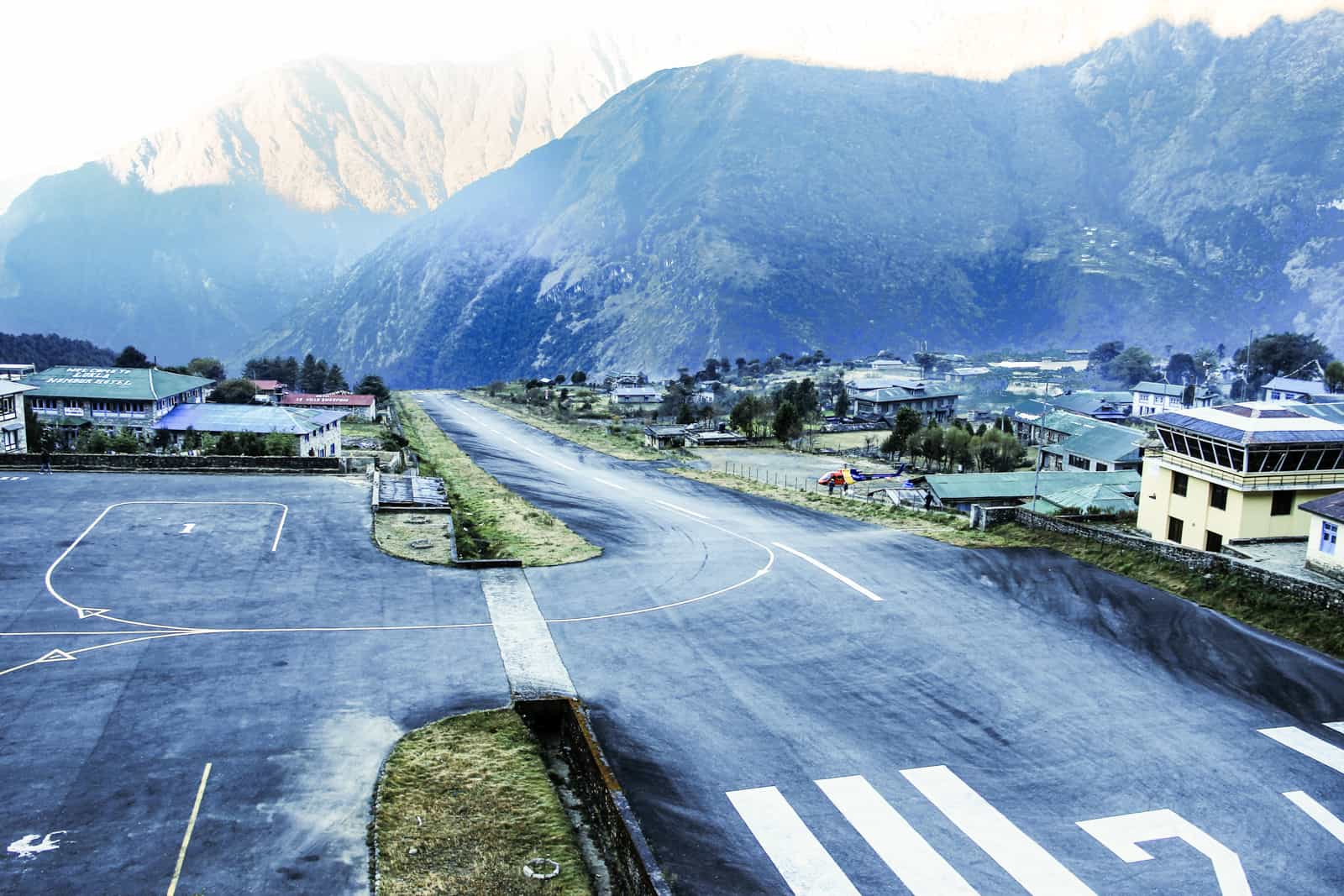
The short mountain-side runway at Lukla airport
Cheering at the successful landing and knowing that we were still alive after this nail-biting experience, we went to breakfast full of excitement about the trek ahead – a three-hour, uphill climb that wasn’t too taxing. Little did we know how much harder it would be and how much colder it would get.
Savour that first night. It’s one of the most comfortable.
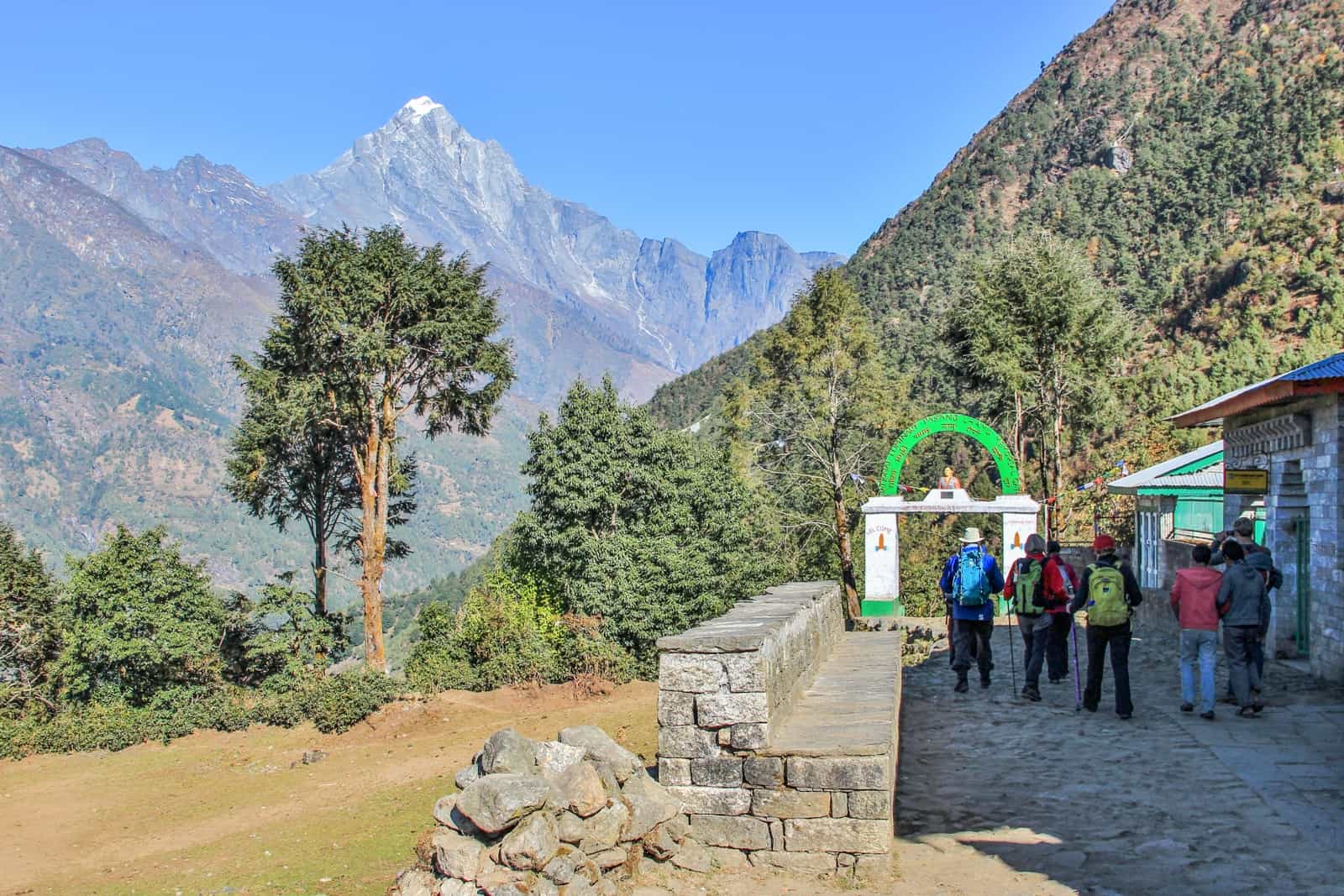
The group begins the Everest Base Camp trek from Lukla.
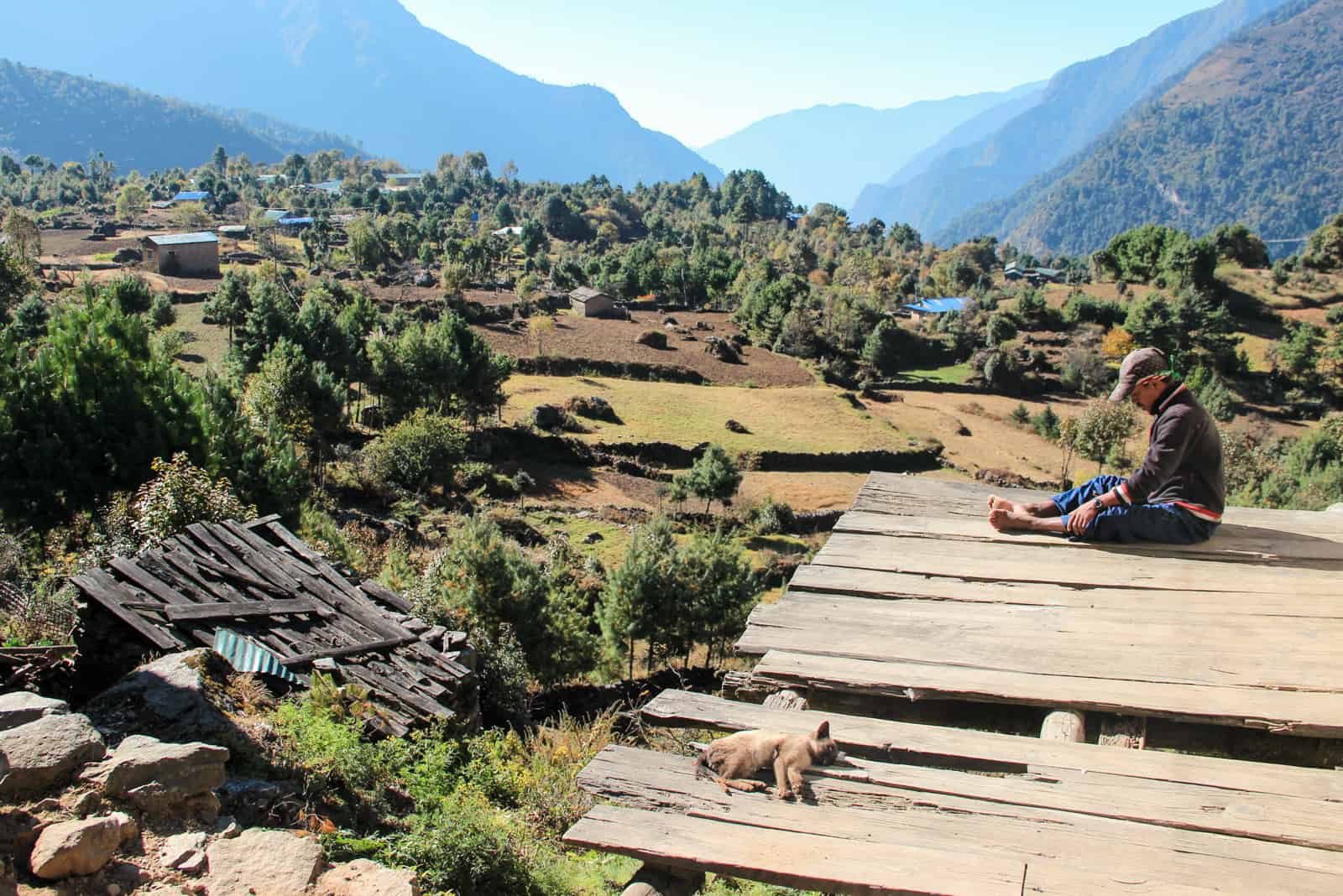
The forested Sagarmatha National Park on the Everest Base Camp Trek
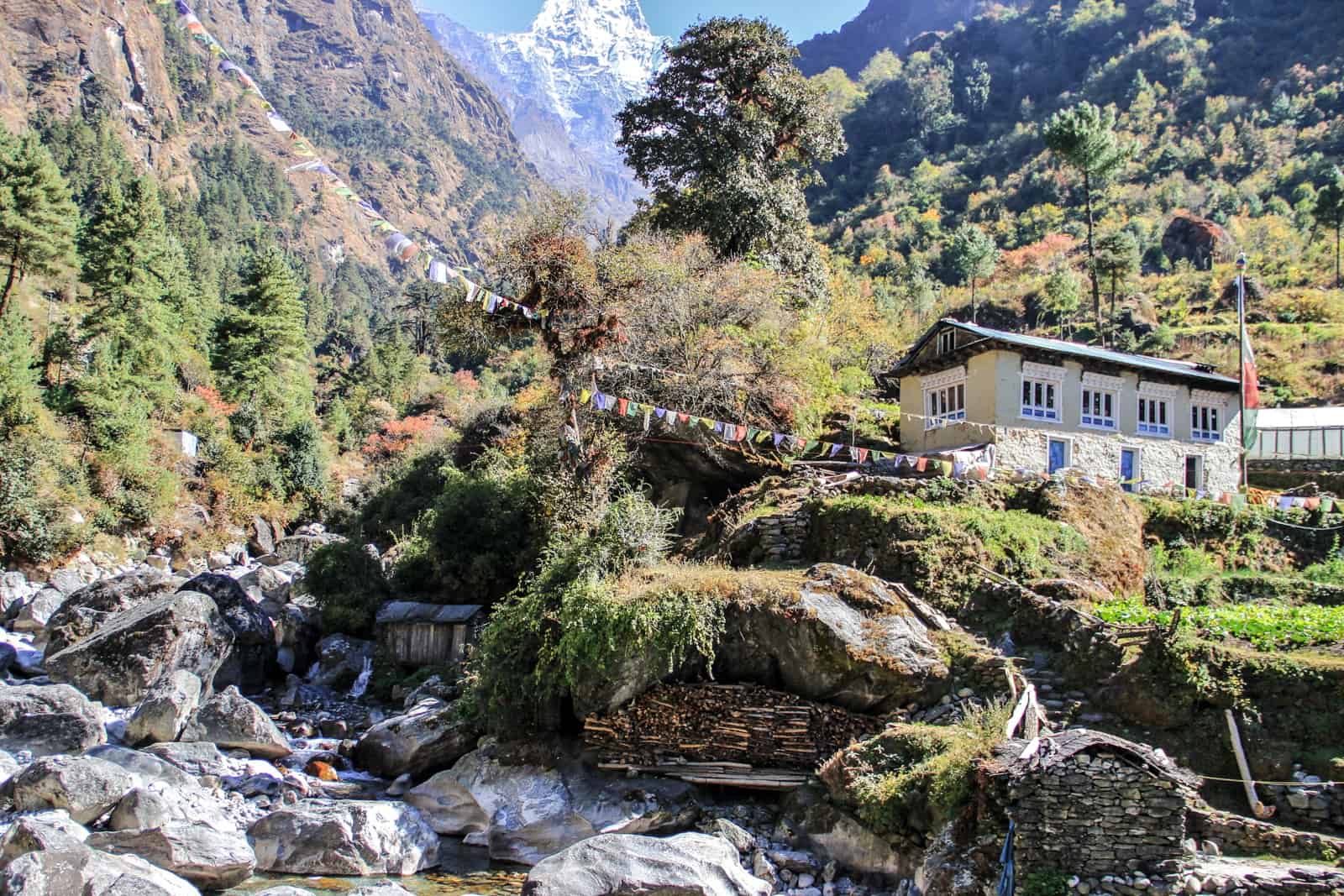
Constant mountain views on the trek
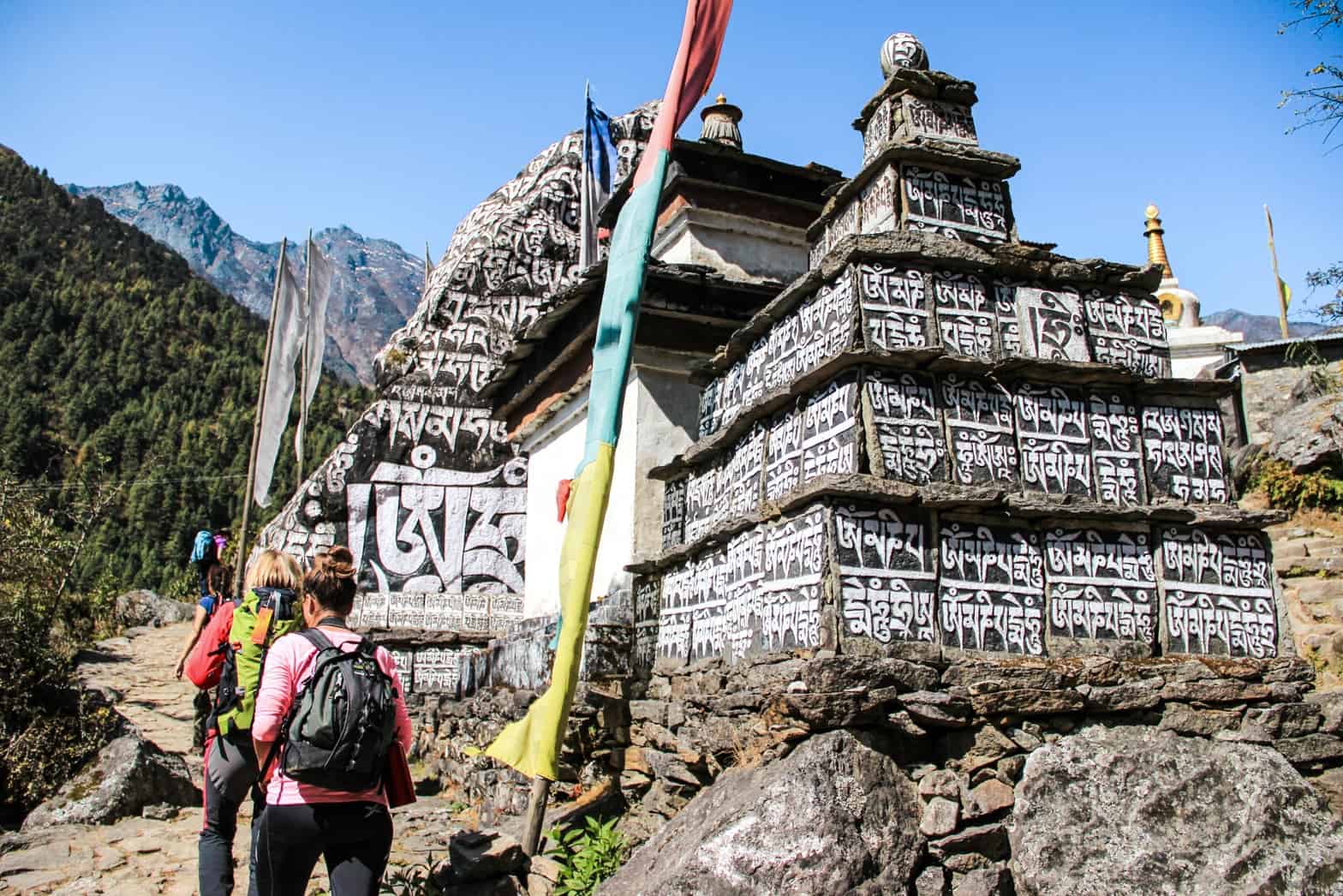
Passing a sacred site on the Everest Base Camp Trek – one of the many temples and monuments along the way
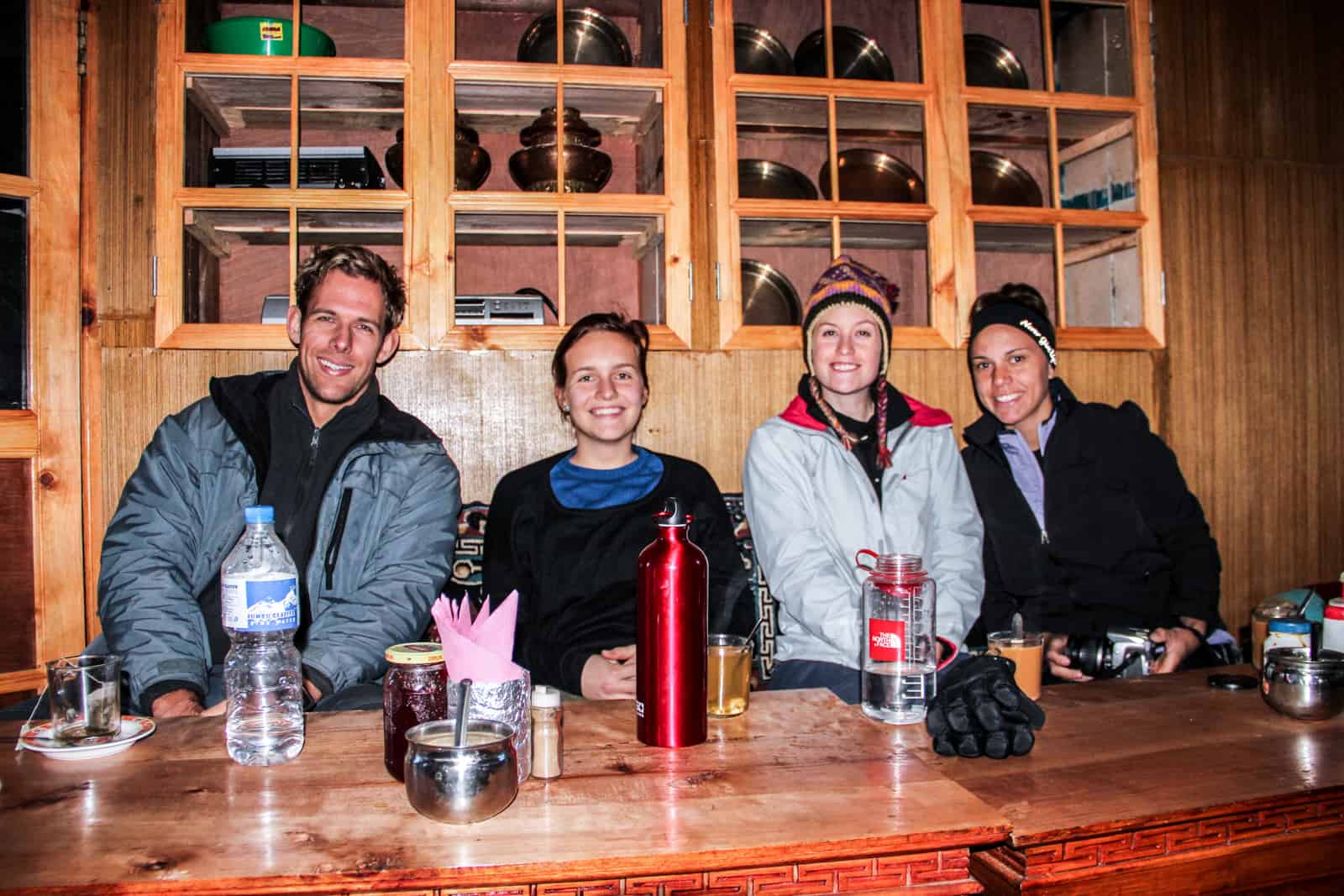
Reaching the teahouse in the afternoon.
Everest Base Camp Trek Itinerary: Day Two
On day two, we made our way to the well-known Namche Bazaar – one of the biggest rest areas full of markets, restaurants and Wi-Fi cafes. Sounds amazing, right? Yet reaching this haven at 3,440 metres requires an extreme effort.
Said to be one of the toughest parts of the Everest Base Camp trek, I found this day one of the hardest, alongside the day of getting to Everest Base Camp itself.
It involved six hours of high climbing and steep steps through stunning forest, crossing rivers via long, swaying suspension bridges and relentless physical exertion in dusty, dry heat, which sent my adrenalin levels pumping so high that all I could do when I reached the lodge was sit and cry in exhaustion.
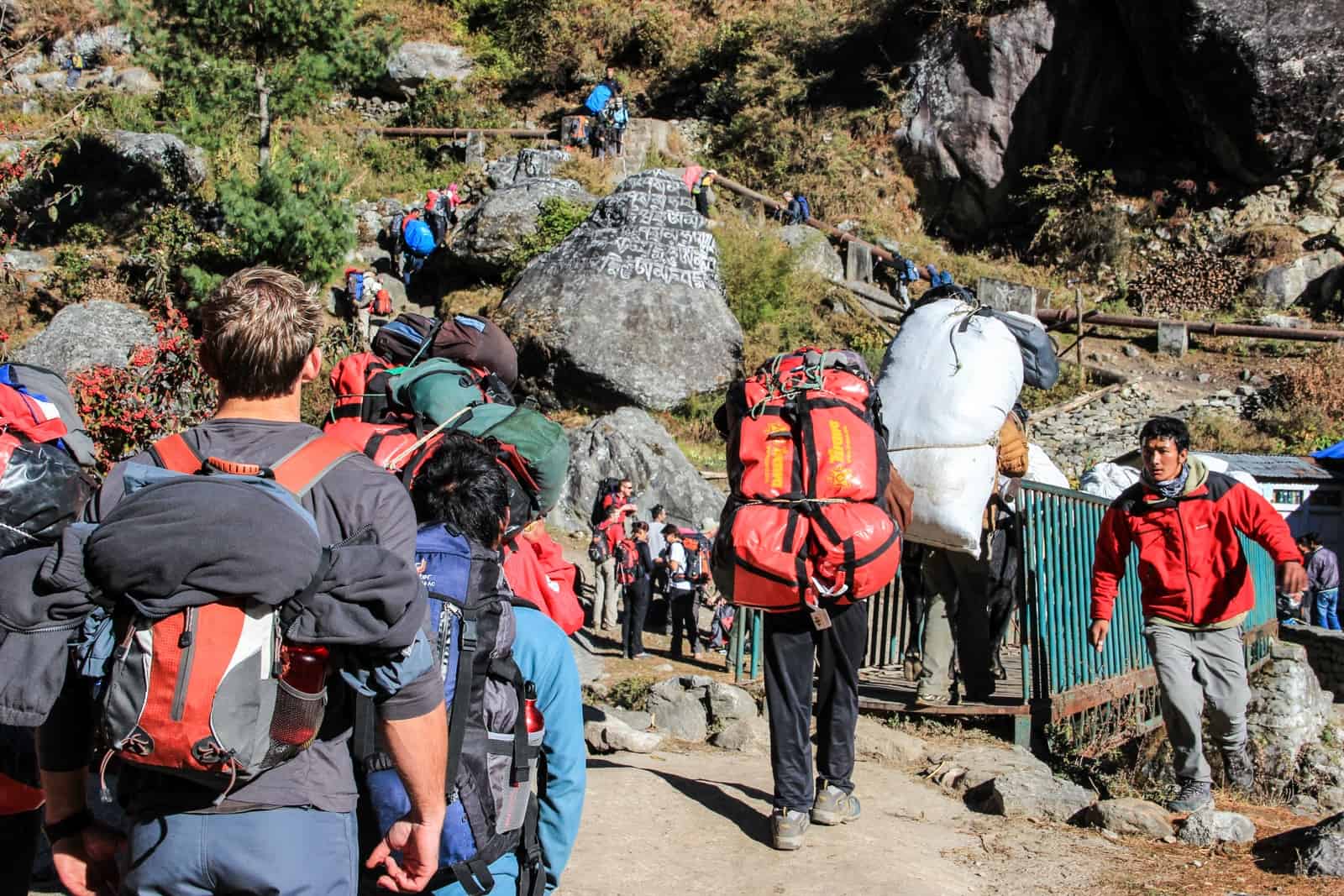
Bridges and steep climbs on Day 2
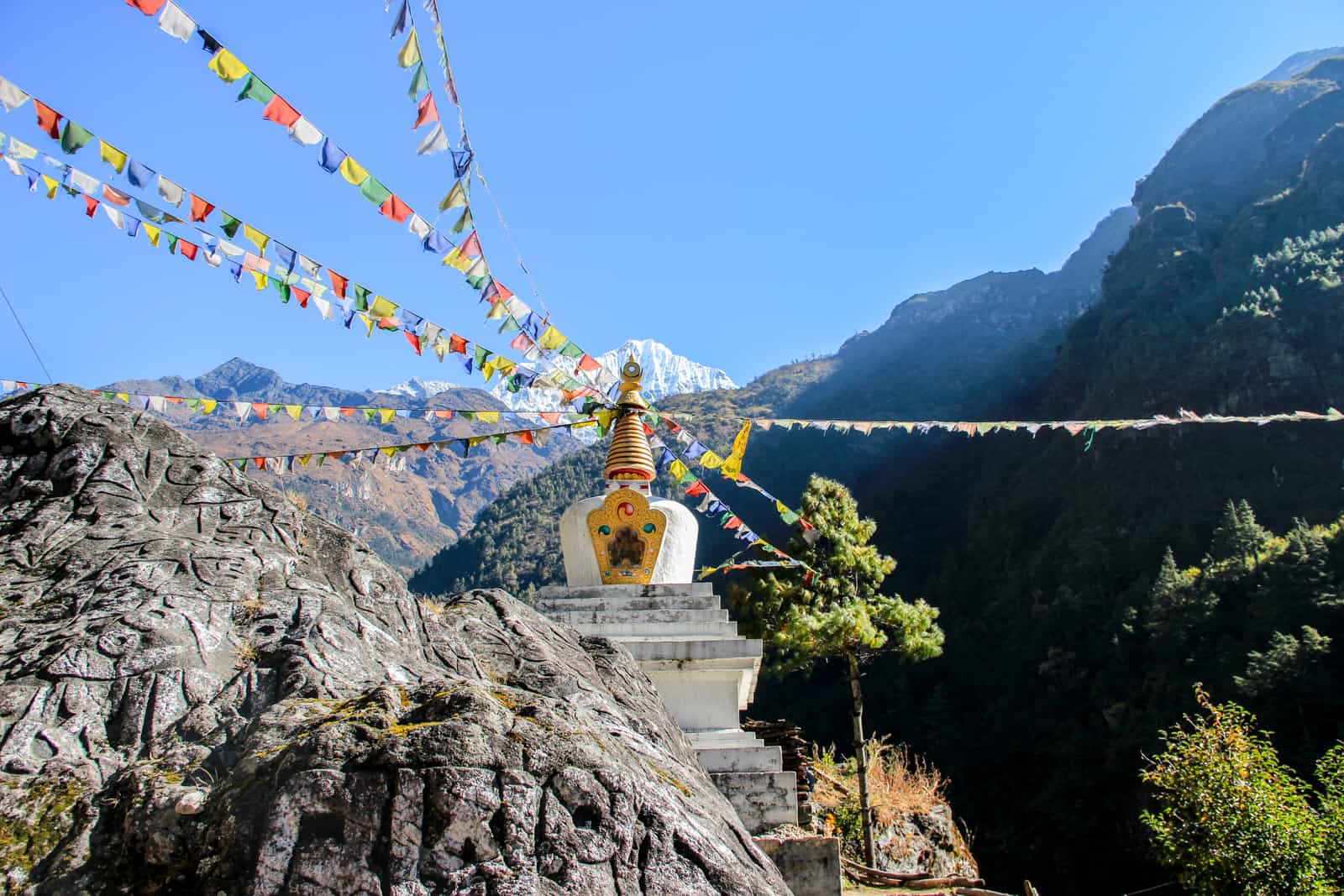
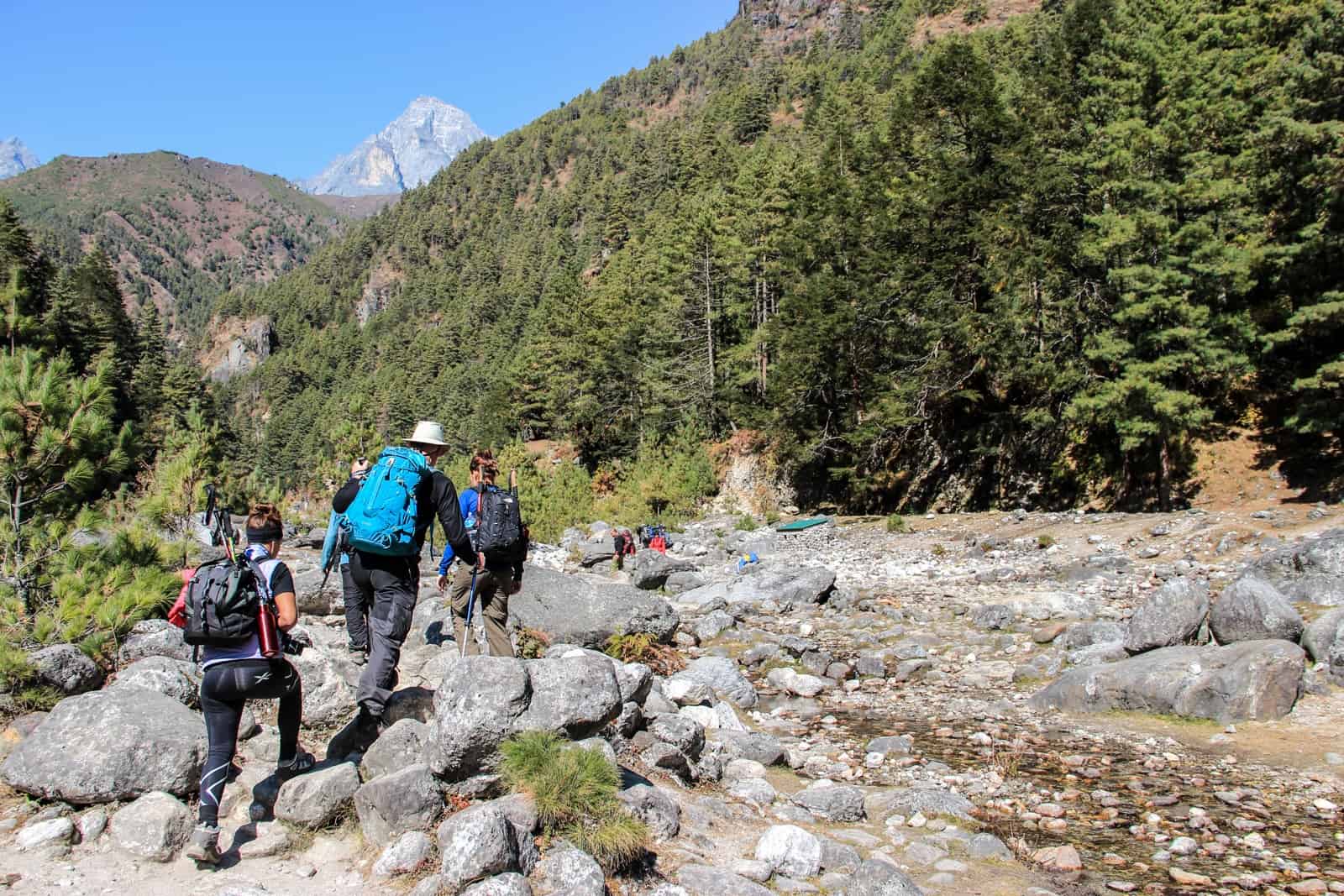
The long push to Namche Bazaar
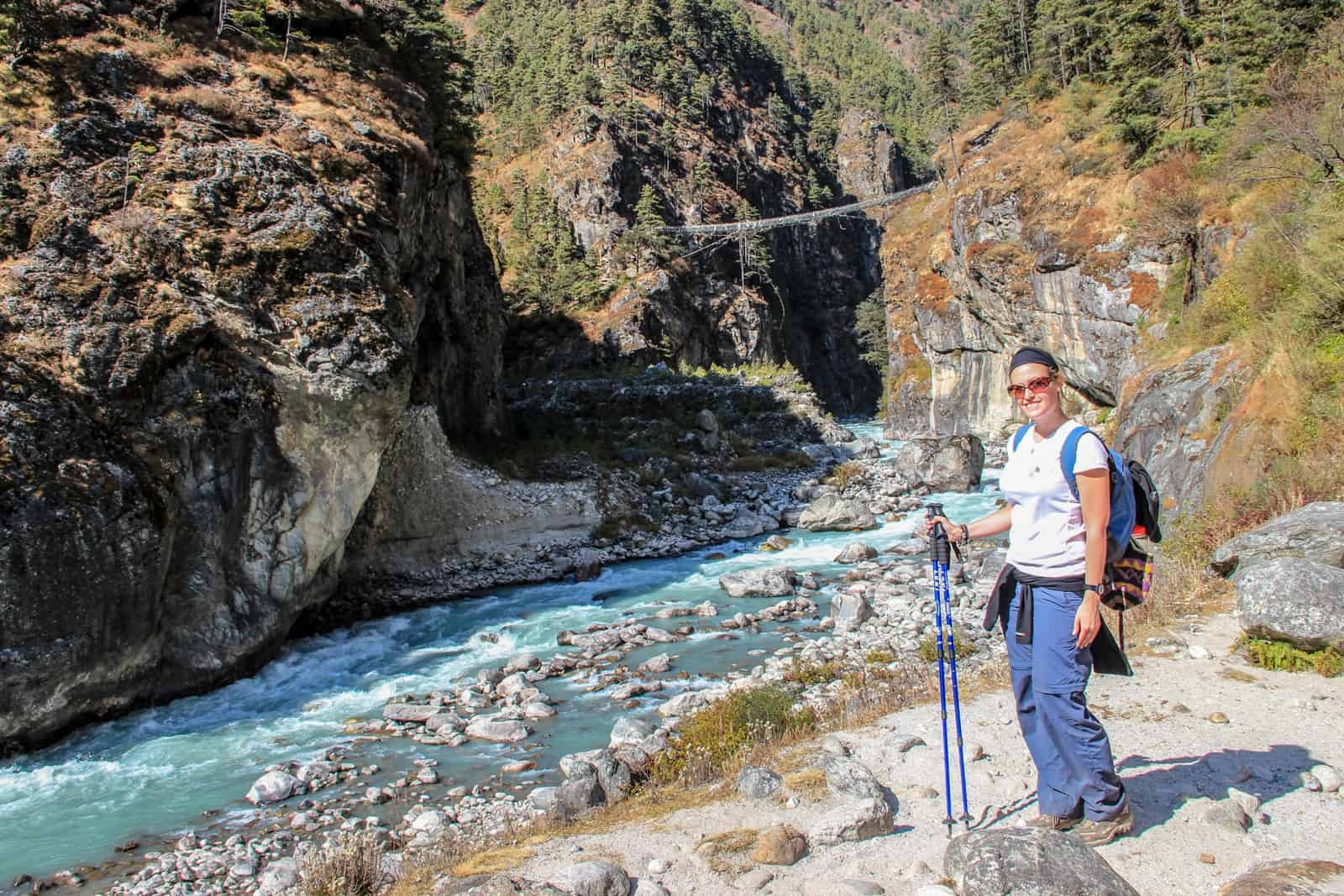
A rest stop before continuing. See the bridge in the distance?
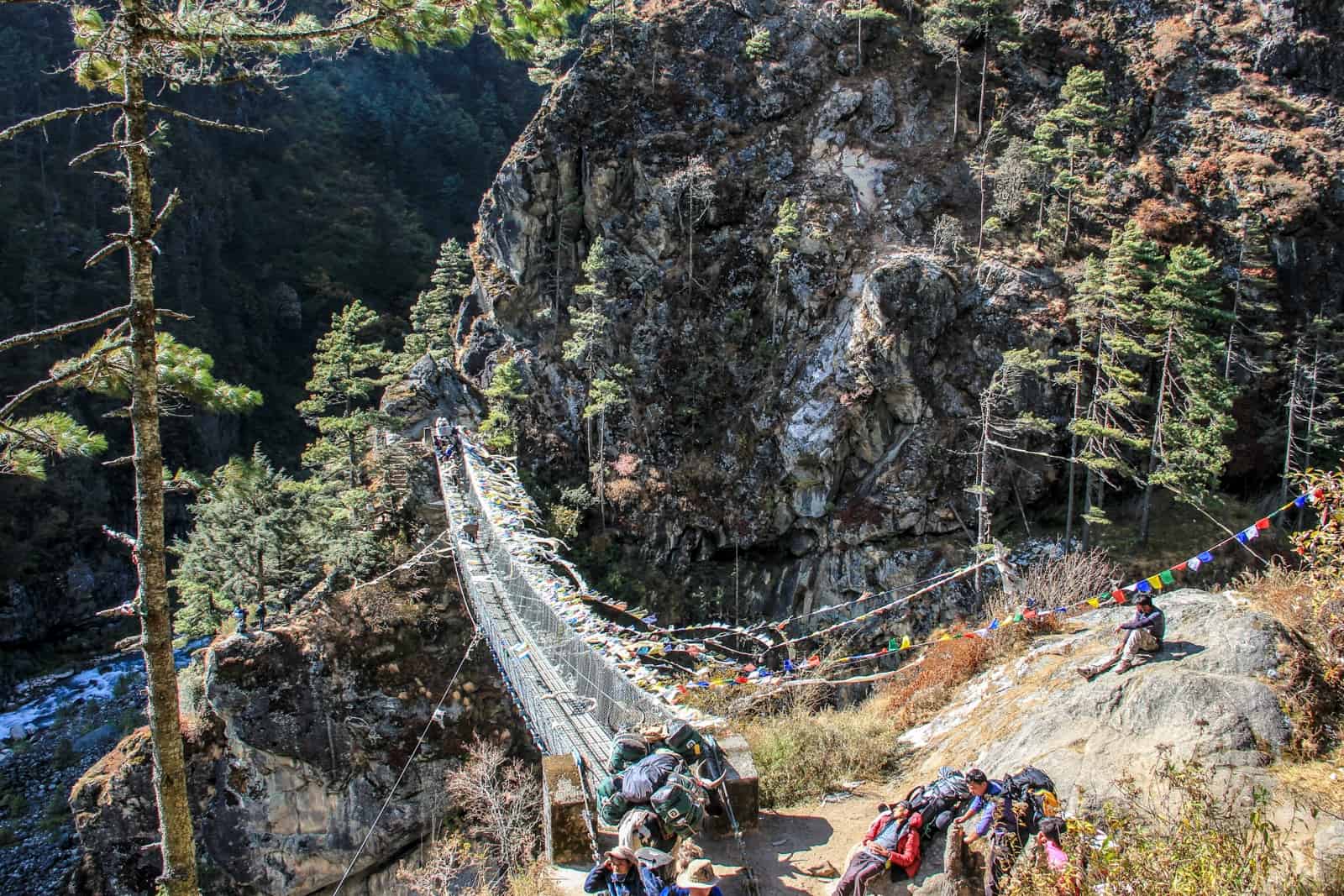
There it is. One of the many suspension bridge crossings on the Everest Base Camp Trek
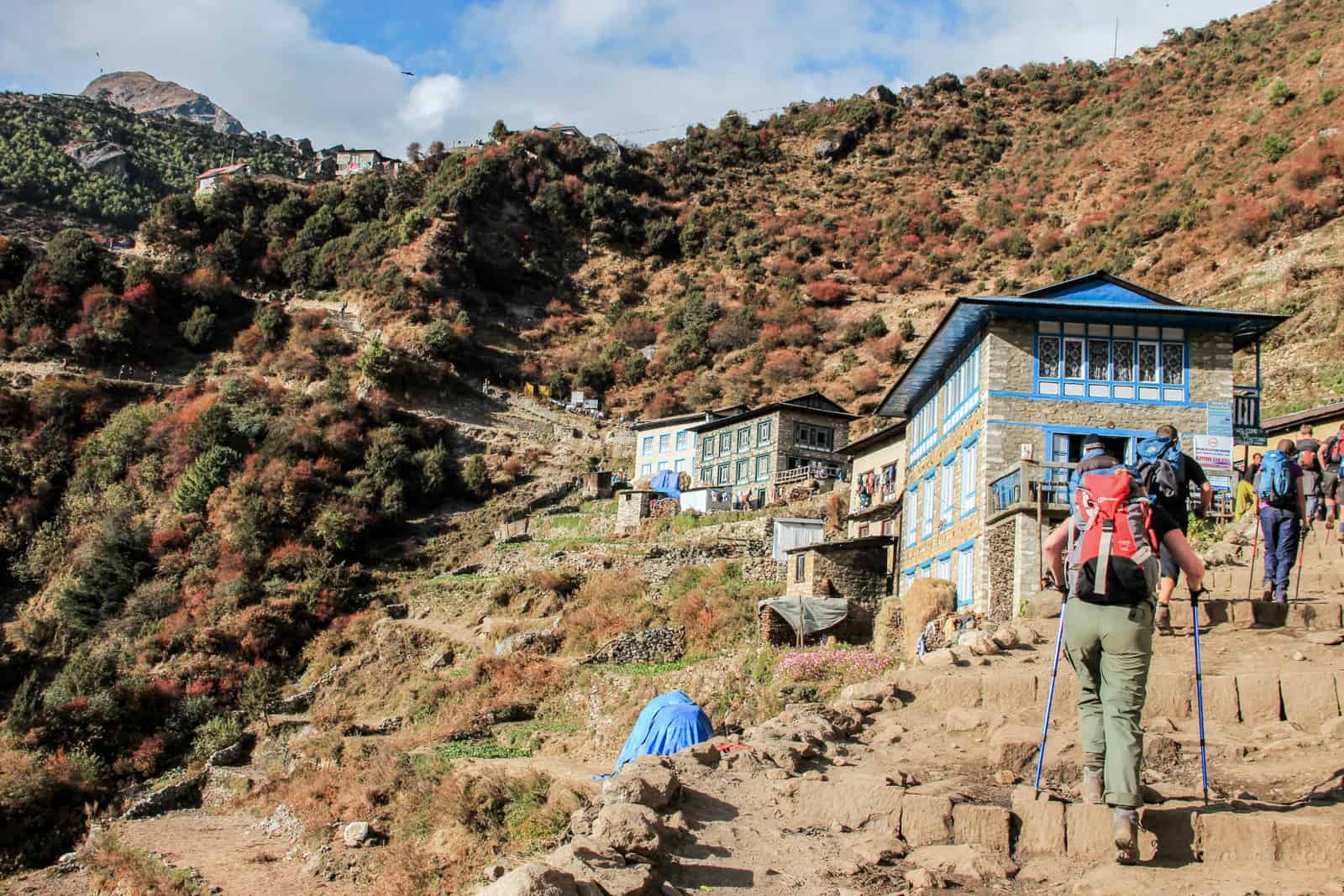
One of the last uphill segments towards Namche Bazaar
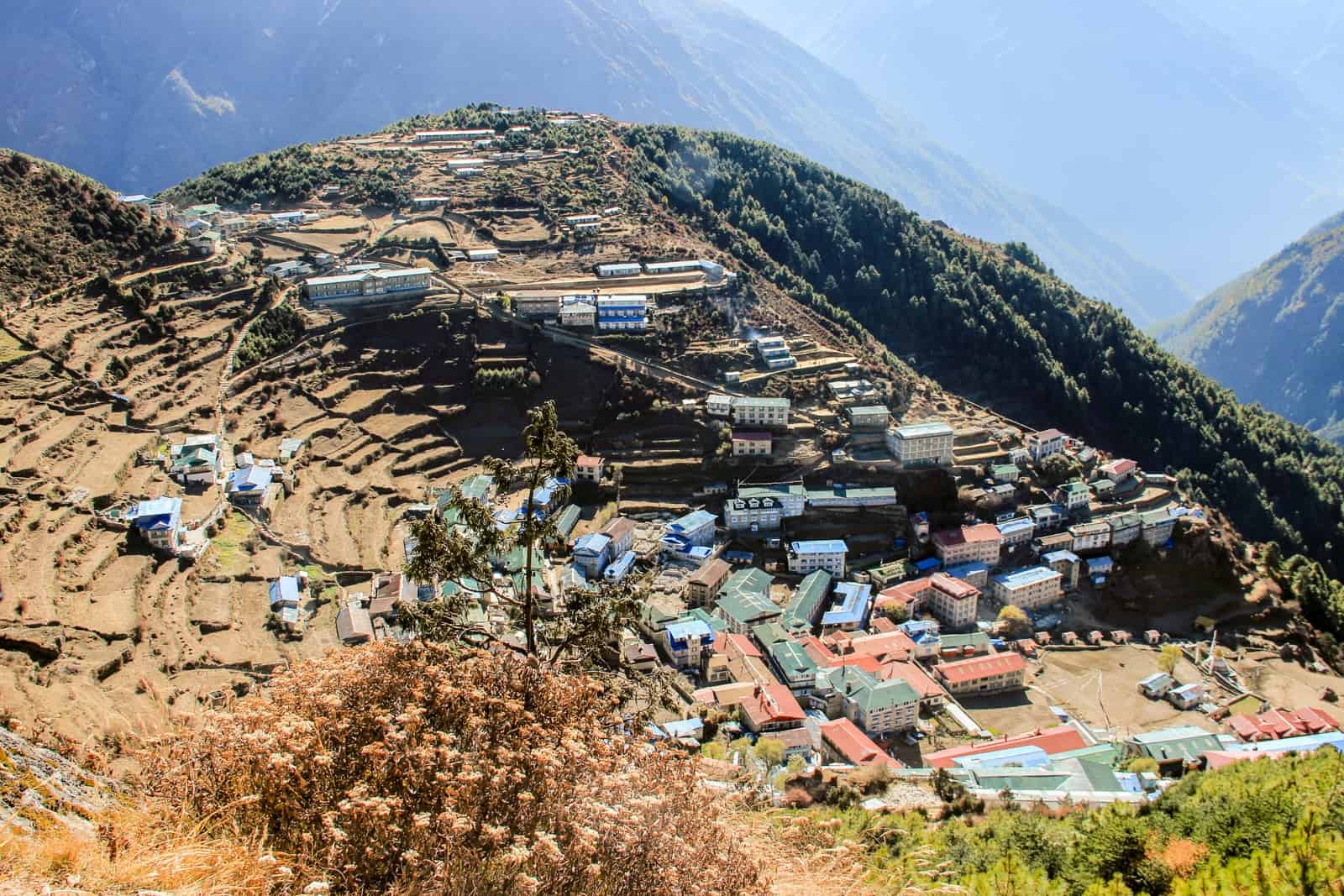
The elevated view of Namche Bazaar on approach
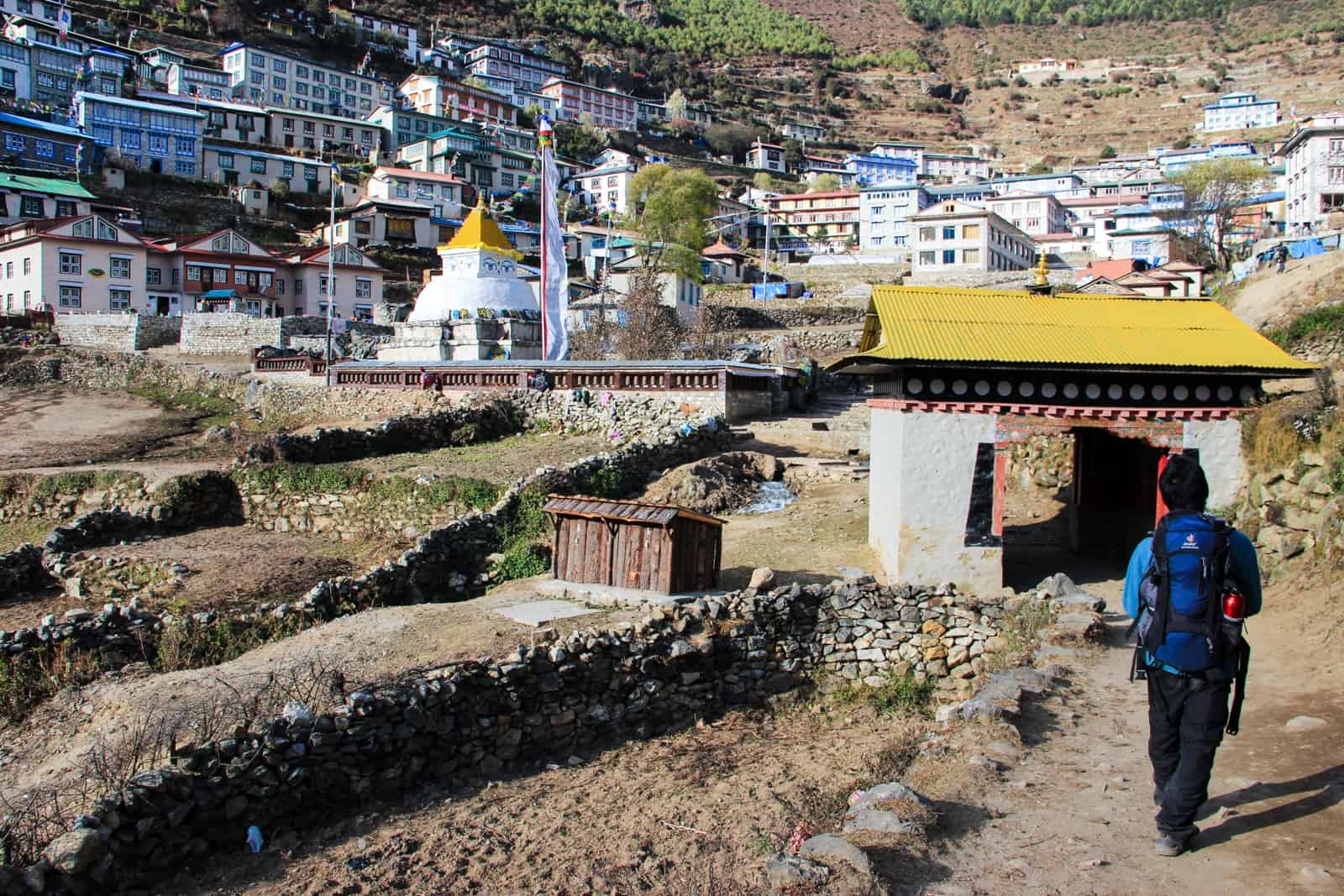
Reaching the gate of Namche Bazaar.
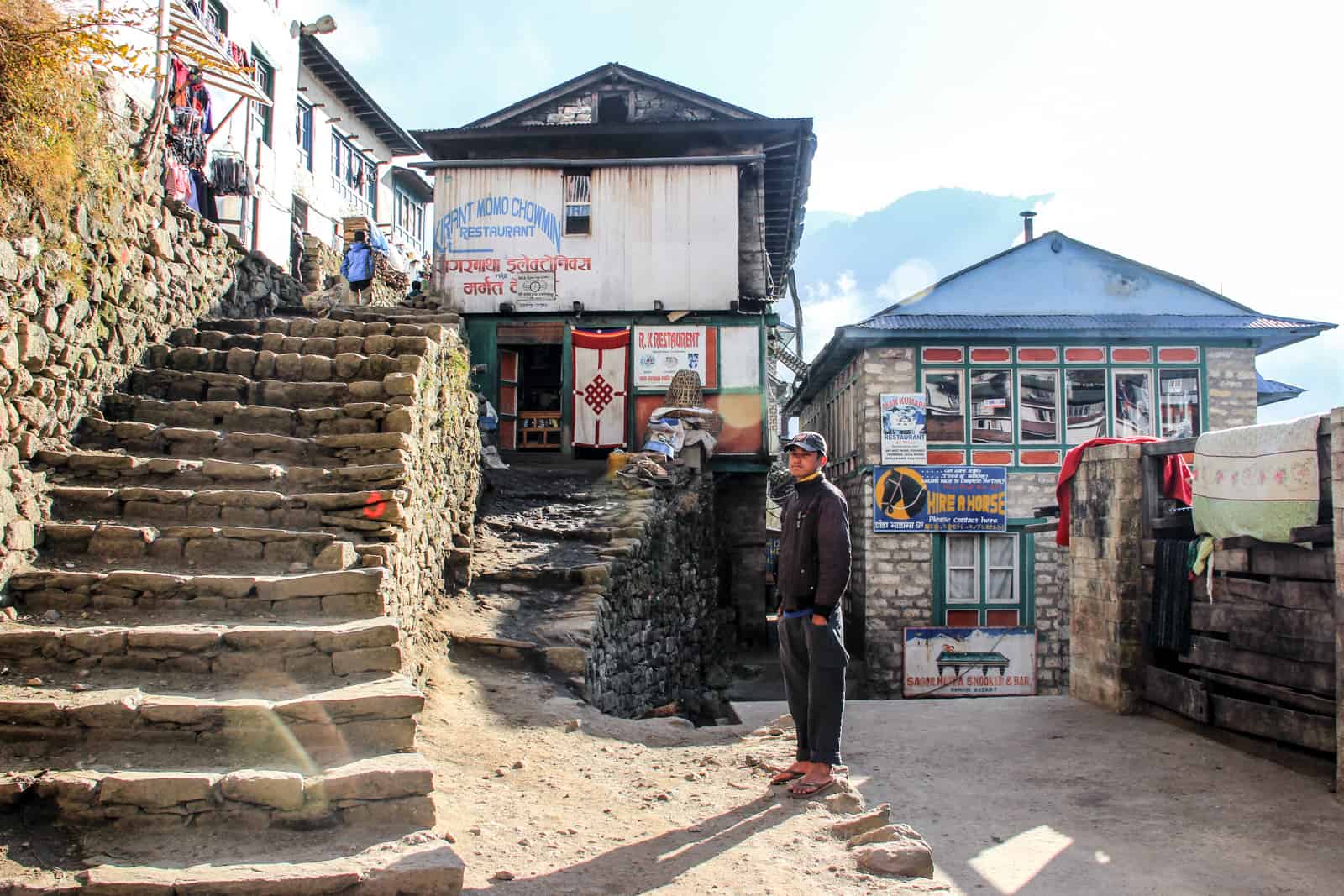
You spend two days at Namche Bazaar for acclimatisation.
Everest Base Camp Trek Itinerary: Day Three to Day Seven
Five more trek days follow, of which two are ‘acclimatisation days’. The first acclimatisation day is day three (the second day you spend in Namche Bazaar) when you trek to the villages of Thame and Khumjung, and day six of the trek when you are in Dingboche at 4,260 metres, and you trek to Chhukung village or Nagarzhang Peak.
An acclimatisation day means climbing. It’s often called a ‘rest day’, but this is a glittery term for an acclimatisation day. Sadly, it is not an opportunity for a lie-in or to put your feet up. You climb high and sleep lower, so while you are not trekking for three to six hours, you will spend approximately two hours hauling yourself up a steep hill for your body to get used to the next stage of high altitude – a painful but necessary evil which makes the forthcoming trekking days a little easier.
Your body will start feeling the effects of altitude at this stage. It’s on day four (when you trek from Namche Bazaar to Tengboche) and day five (when you trek from Tengboche to Dingboche) that you start to feel the changes in the air. Just when you thought you had regained your breath, you are off again to reach a higher altitude, a dry run, ready to make the ascent properly the next day.
It’s a heady mix of short and high climbs, but each step is one closer. Day seven is the push towards Lobuche – the final village settlement on the fringes of the Khumbu Glacier, where you will rest before making the final trek towards Everest Base Camp the next morning.
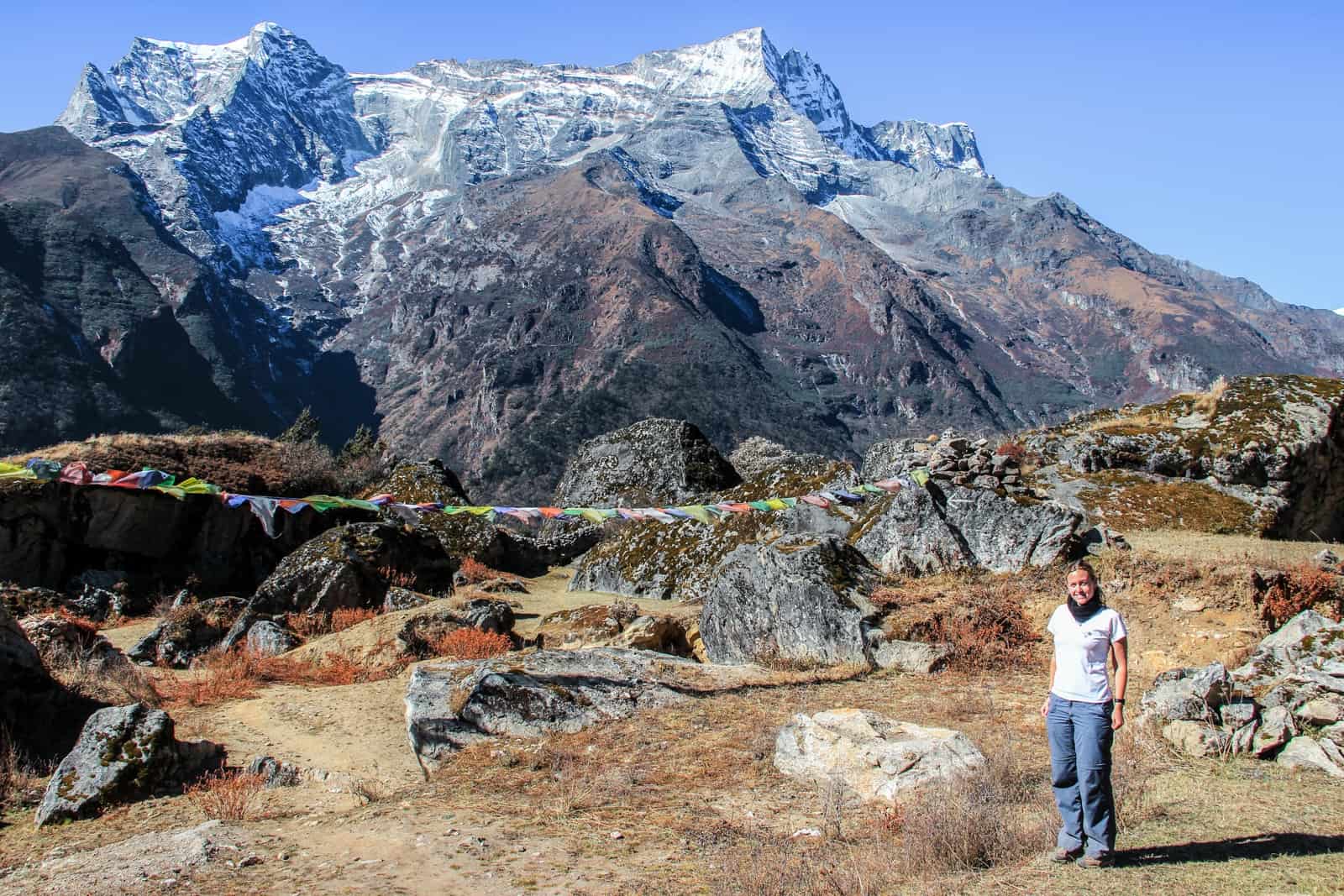
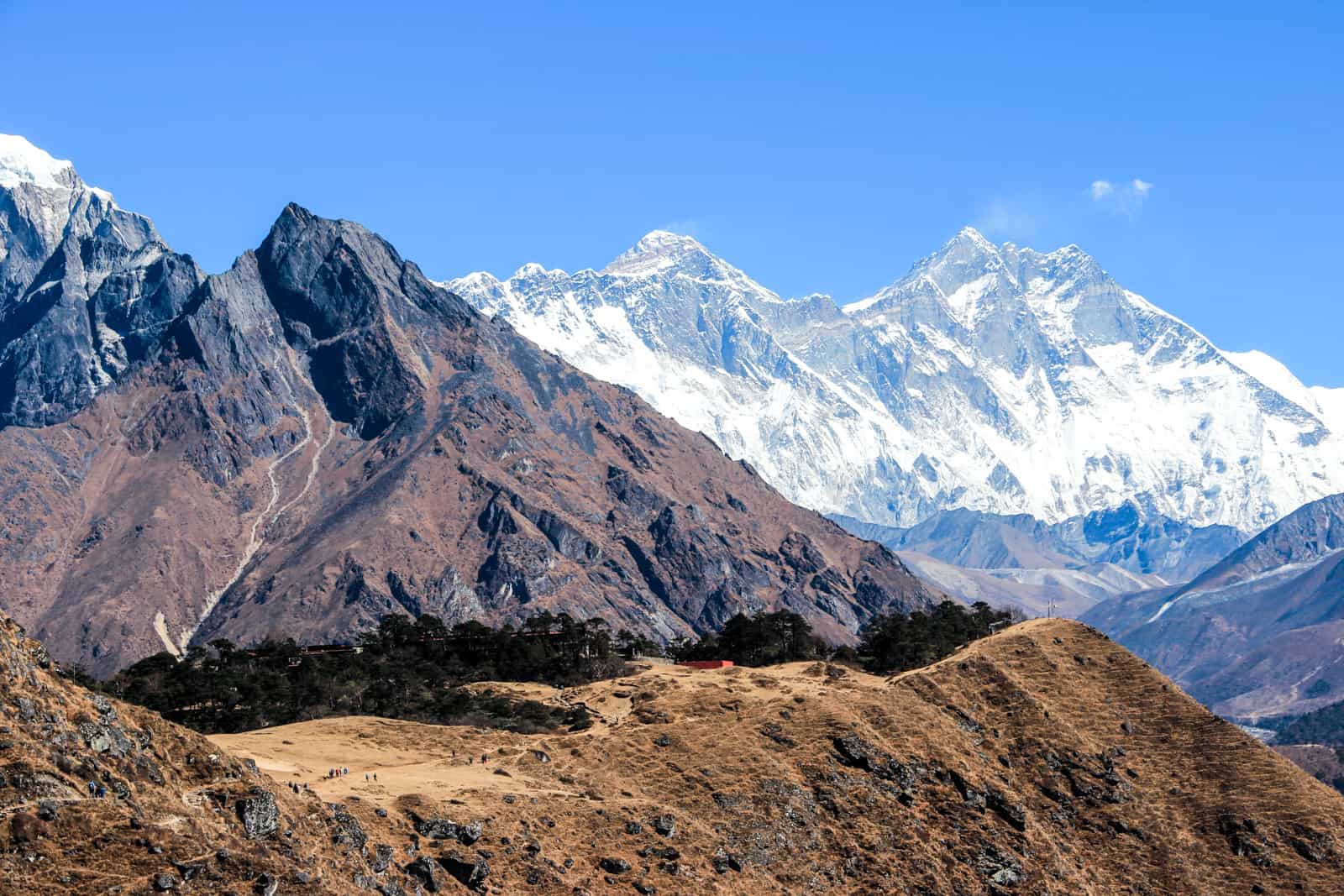
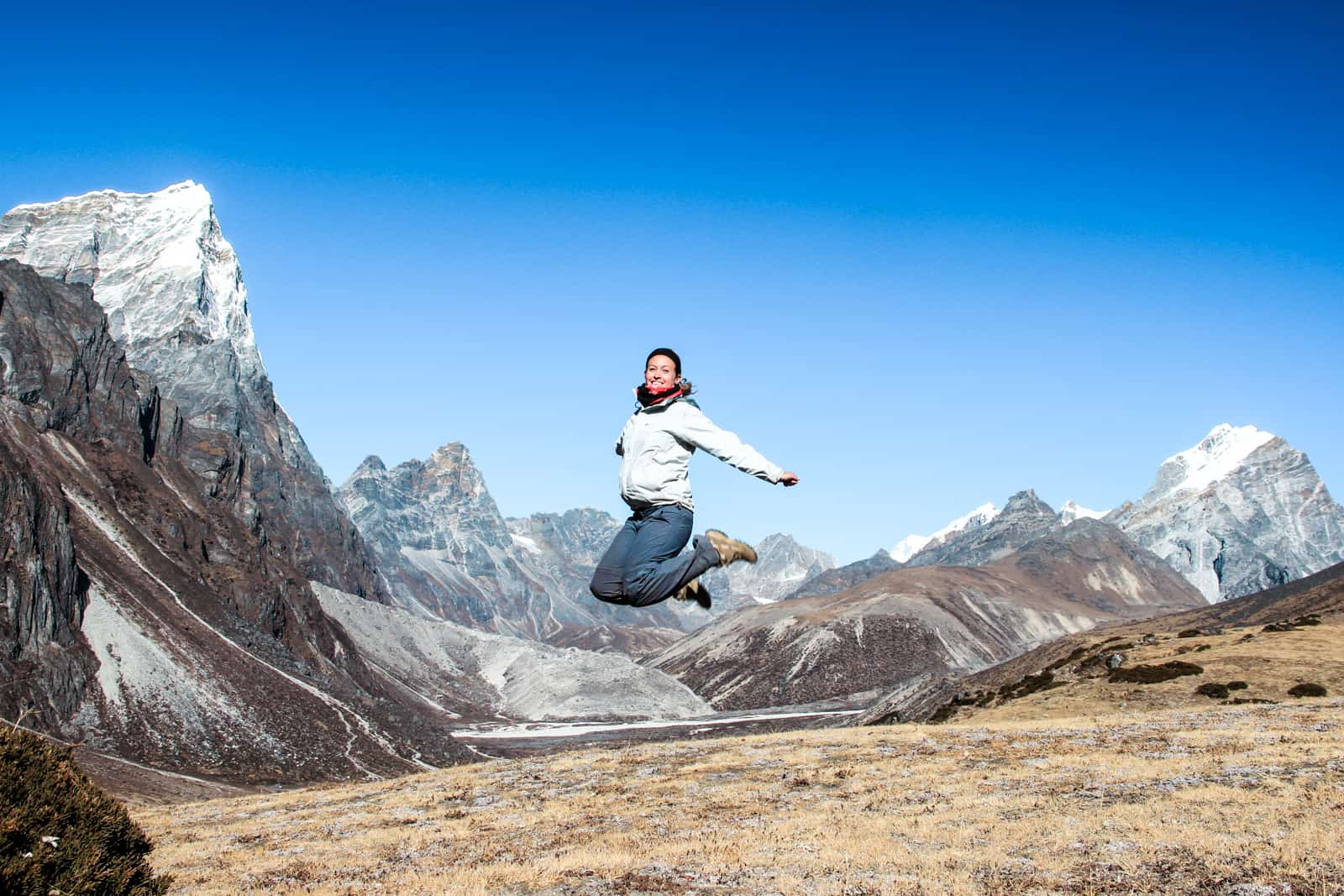
Reaching Mount Everest Base Camp – Exhaustion and Euphoria
Higher altitude, colder temperatures and a tougher climb all come together in a force you think will defeat you. You will never forget the day prior and the actual day of the last, long slog to get to Mt. Everest Base Camp. It’s day eight, and you are beyond exhausted. This becomes some of the hardest few hours of the entire expedition.
The knowledge you are so close to the base, mixed with unbeatable views, are two things that help you pull through it.
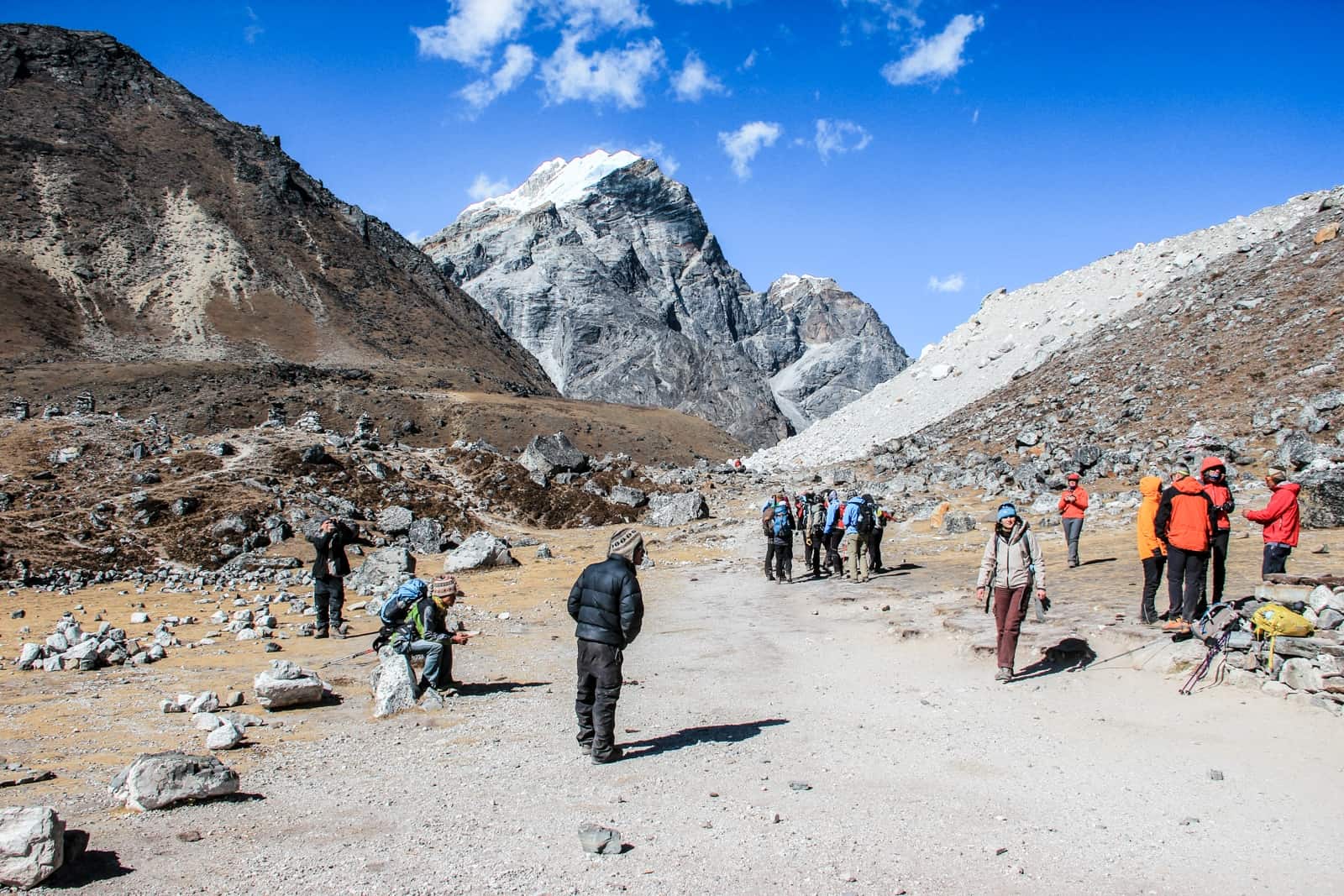
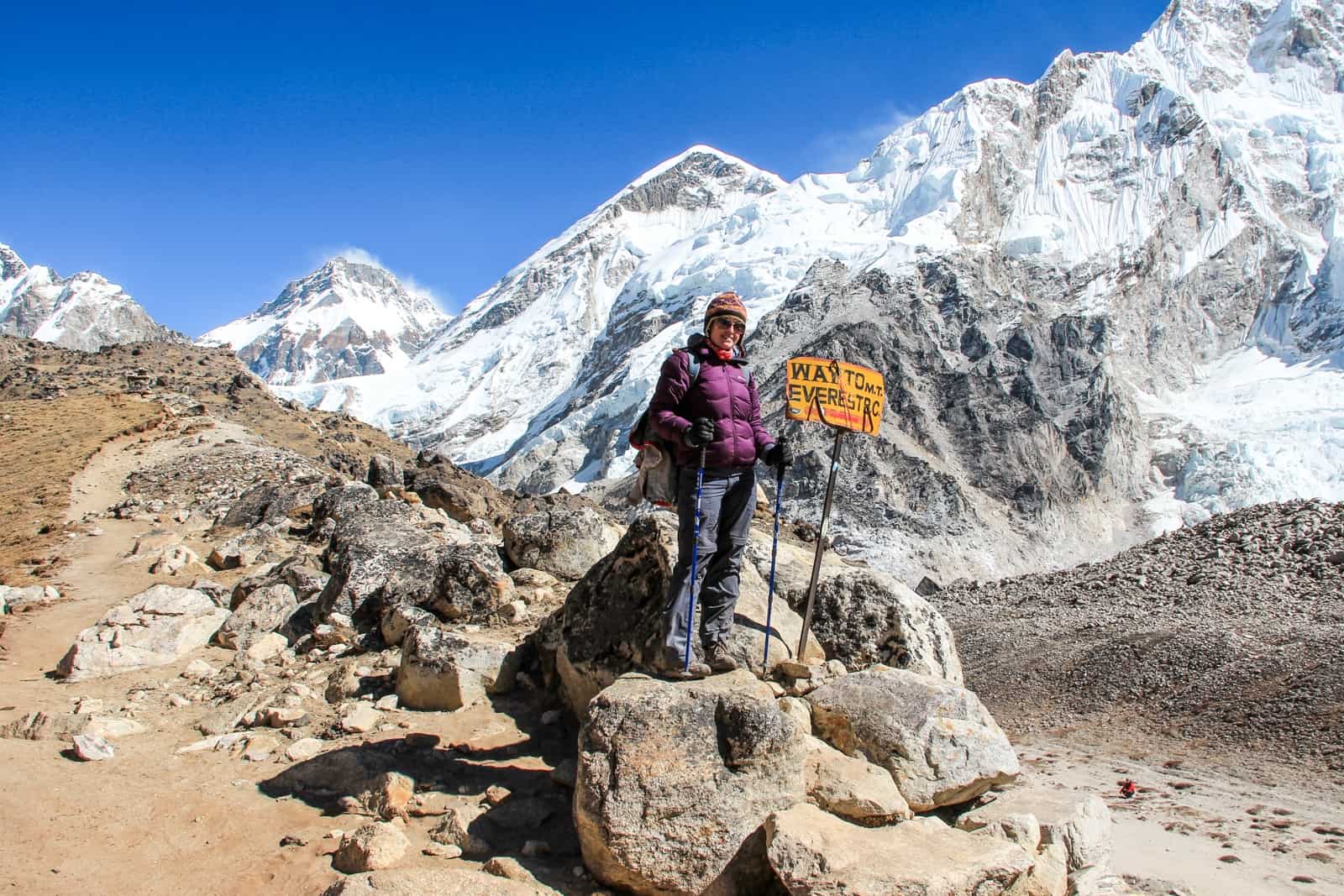
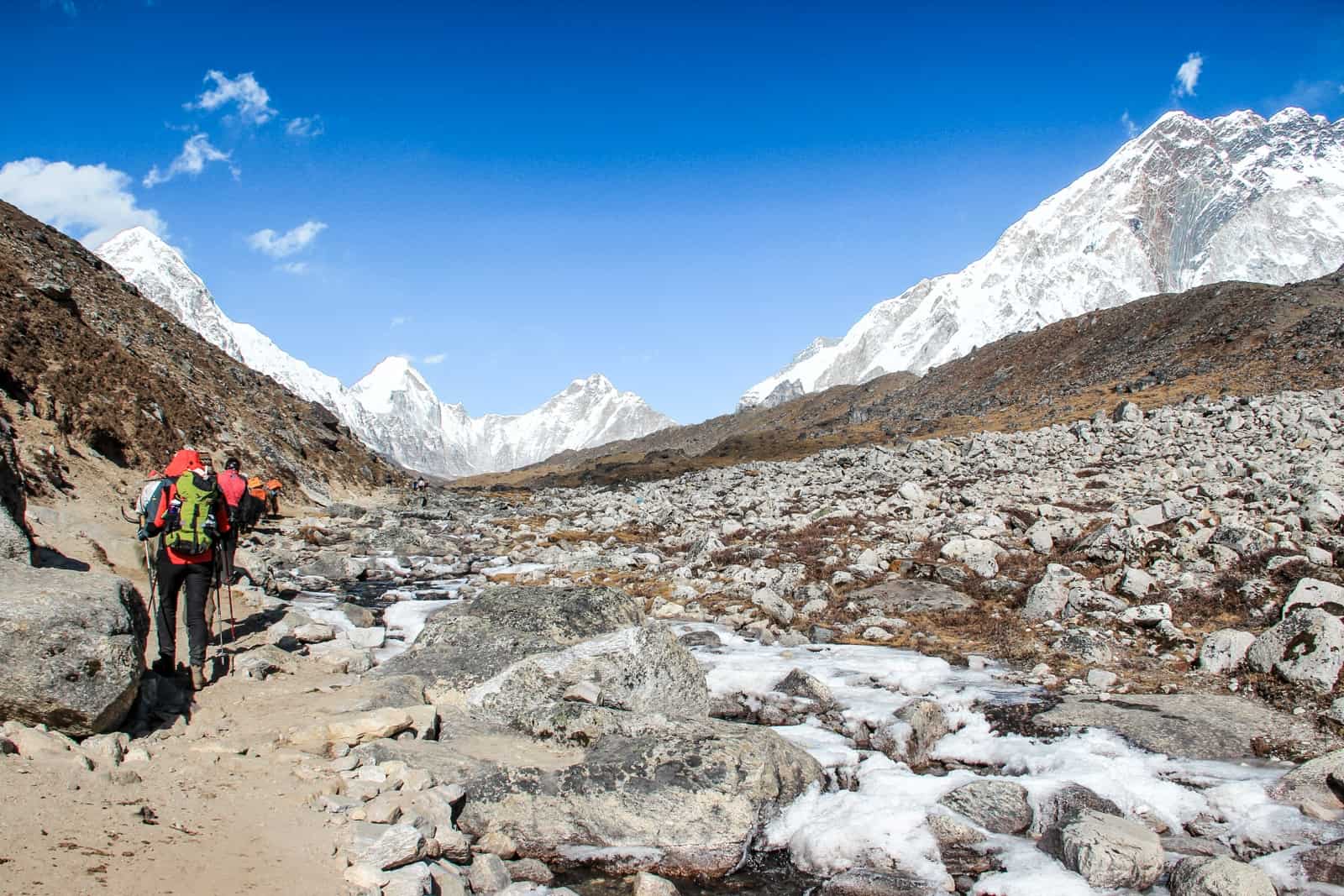
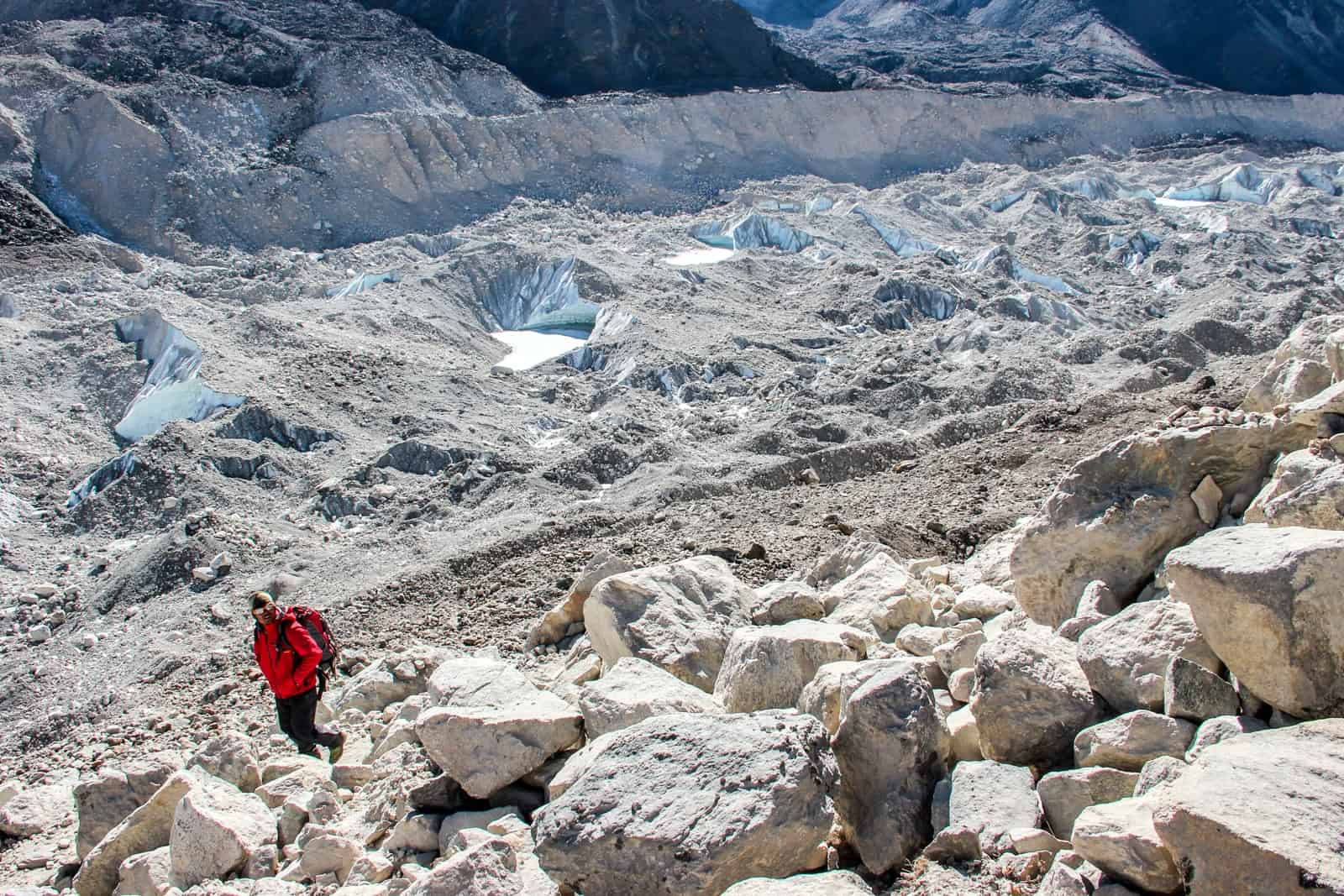
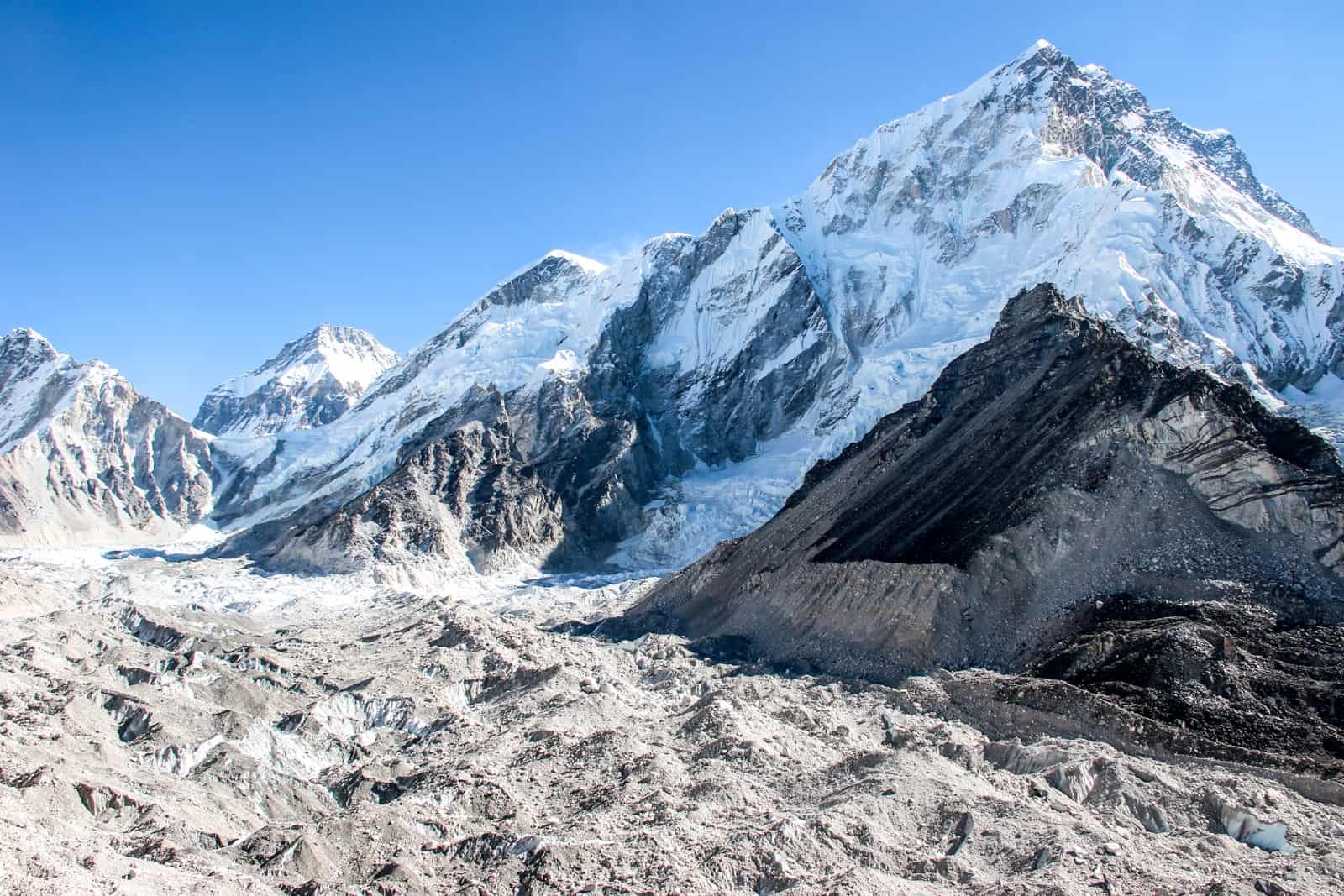
Reaching Base Camp and standing at 5,364 meters is indescribably euphoric, even with depleted energy levels. It’s like standing within a snow globe, where the magnificent snow-peaked mountains, the Khumbu icefall and the imposing presence of Everest loom before you in a striking white glow.
It’s something I will never forget, from the first glimpse of the magnificent view to the congratulatory atmosphere all around me.
Since we were outside of the April to May climbing season, we didn’t encounter the Everest camps like those in the famous photos of people climbing Everest. It was, therefore, not a land filled with people ready to go further or where a huge sign signals your end goal. Instead, you are greeted by a huge rock covered in prayer flags to pose with. Just look up, because that’s the most special thing.
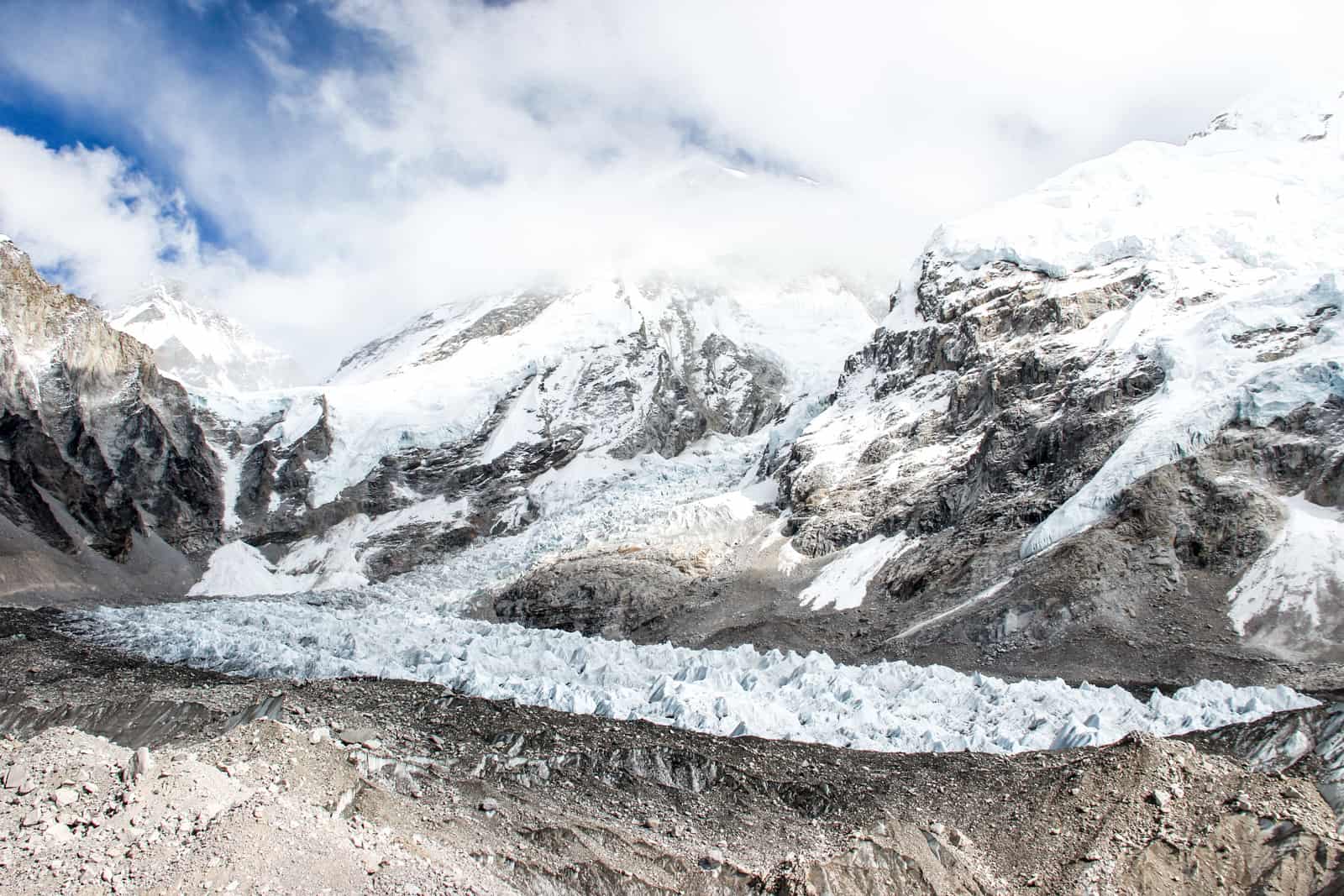
The stretch of spiky ice of the Khumbu icefall at Everest Base Camp
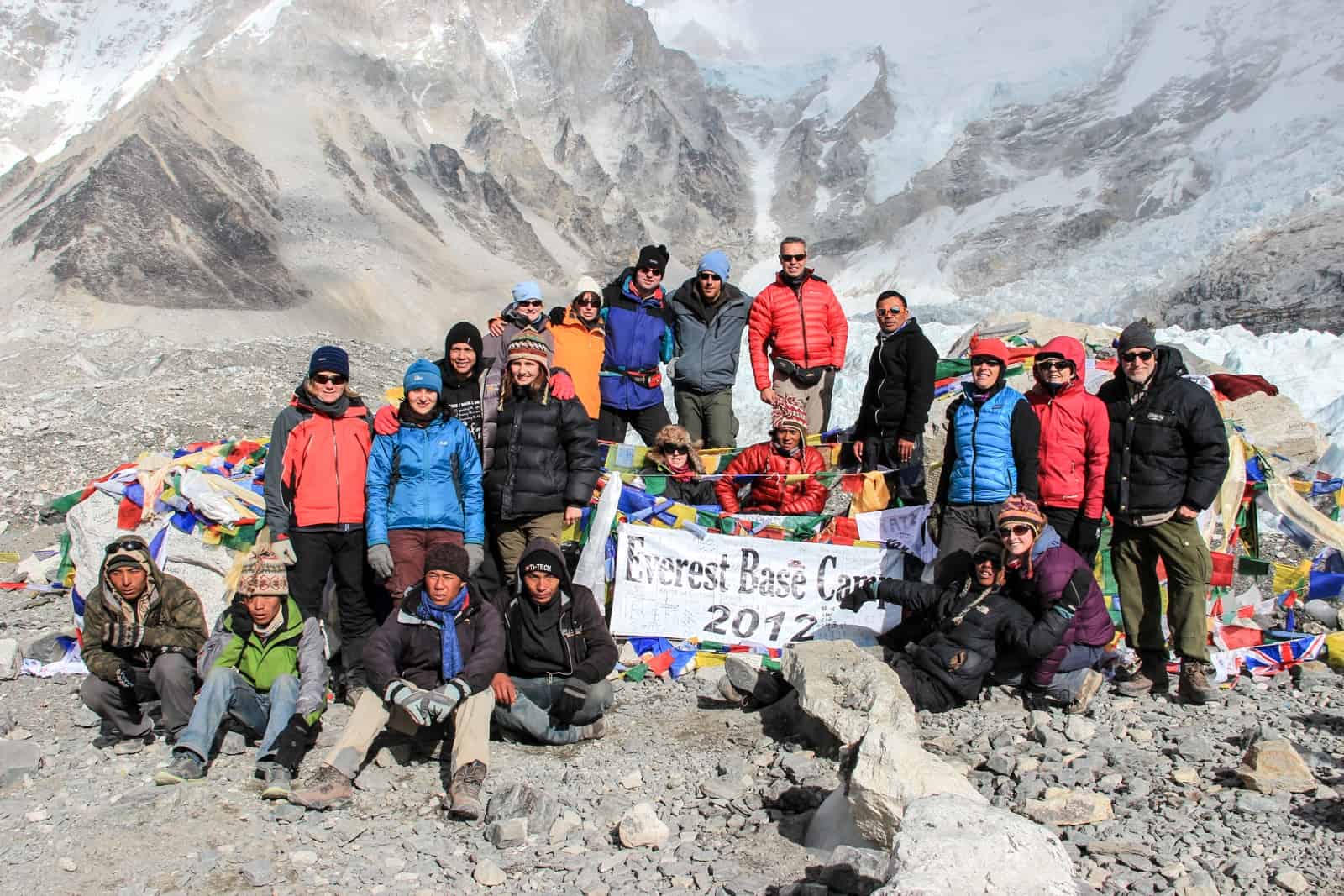
The group reaches Everest Base Camp!
Trekking Back to Lukla after Reaching Base Camp
Everest Base Camp Trek Itinerary: Day Nine to 12
The thought of four days trekking back down is not the greatest and is something you almost have to train your mind not to think about since you have no option but to get back down and on the very same path from which you have already traversed. You’ll often pass the groups on their way up, knowing how it felt in those earlier days of this great expedition.
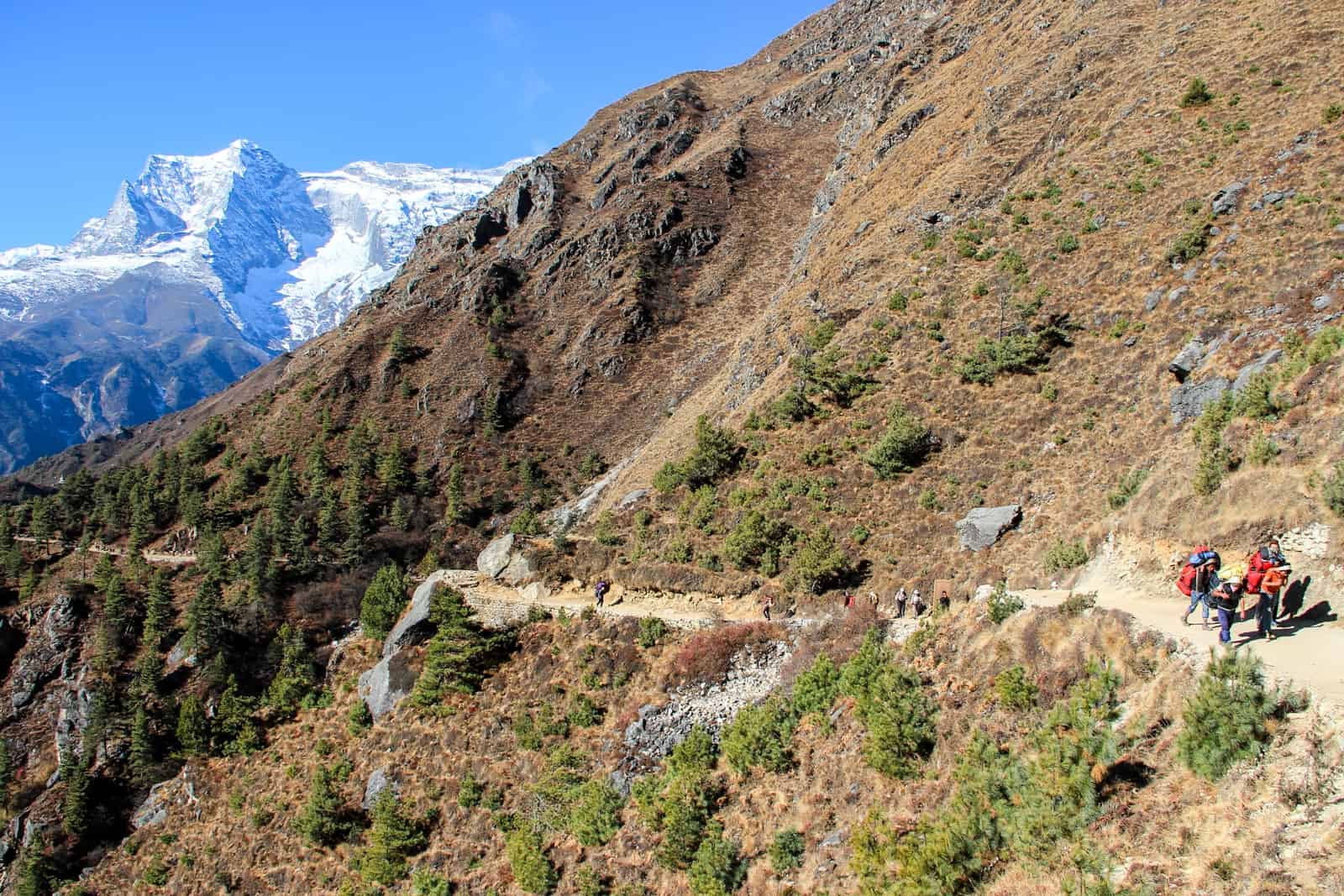
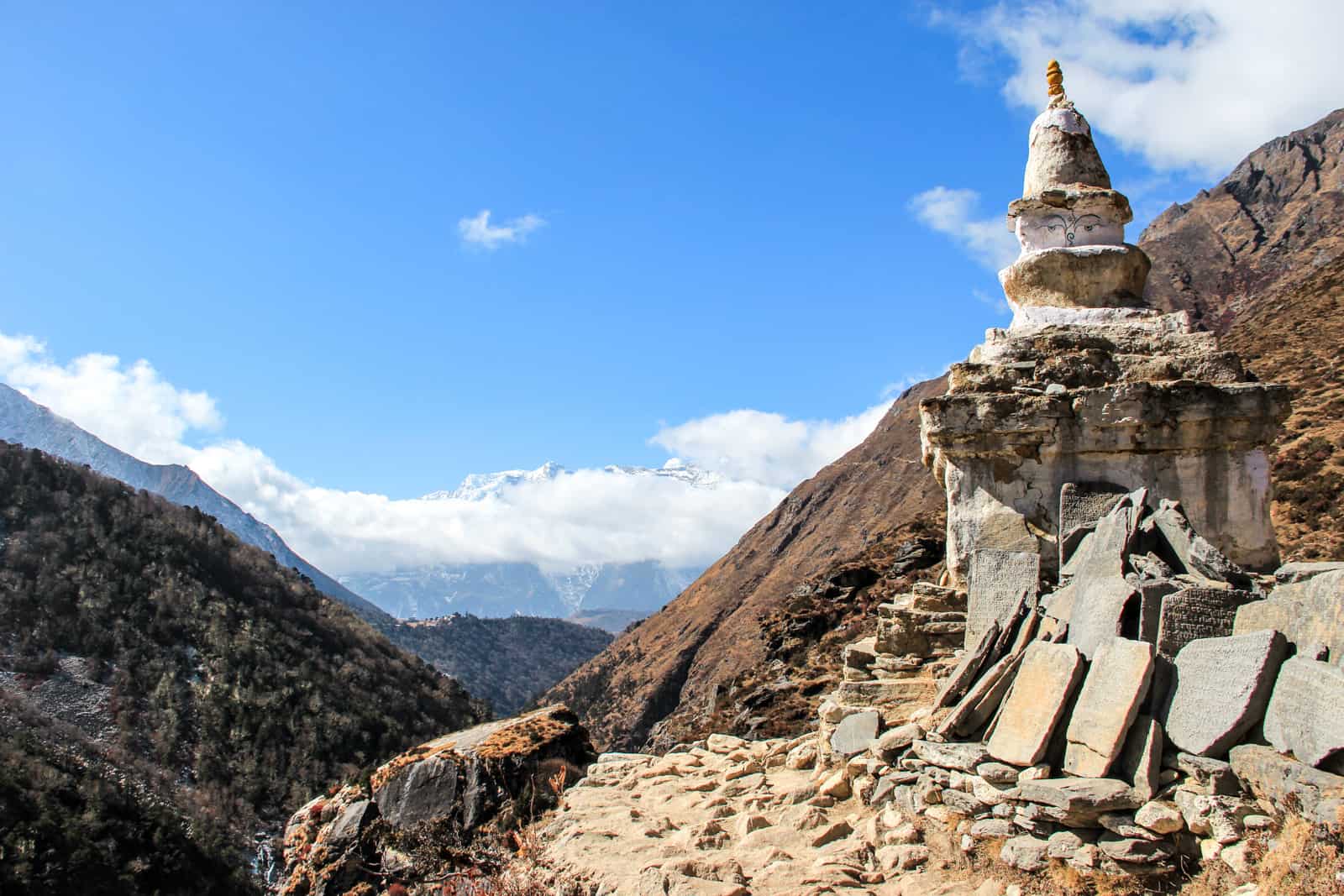
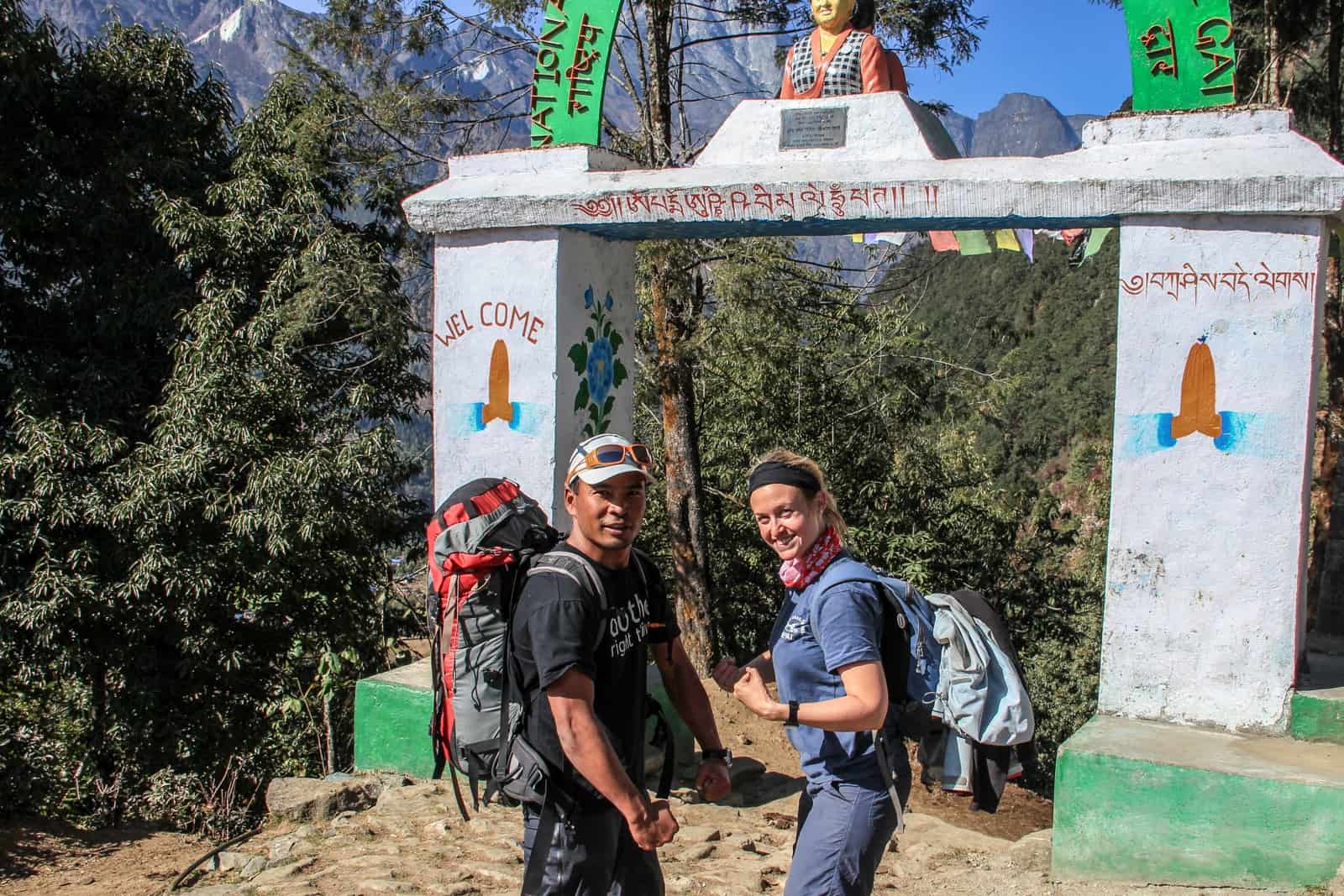
The triumphant return to the starting Lukla Gate
When the way down is tough and feels repetitive, remember one thing. A celebratory party awaits you in Lukla – a land full of happy people, happy hour, decent food, strong cocktails and a rave with your newfound friends. The Everest Base Camp trek is like a detox or a short spell of rehab – no sexual activity, alcohol or meat allowed or advised for 12 days.
Lukla is the release, and you deserve it. Further celebrations continue in Kathmandu.
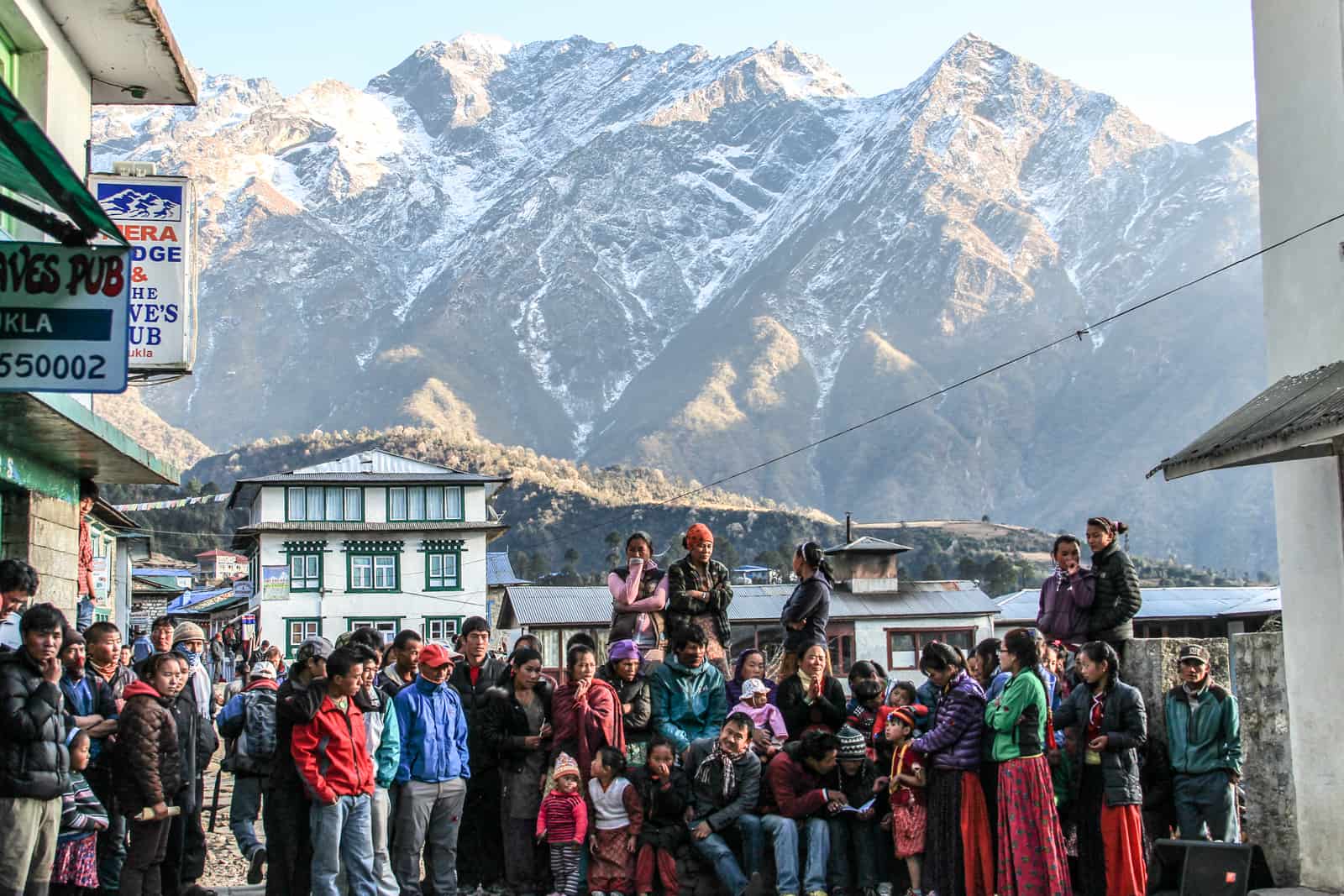
The mountain backed town. of Lukla
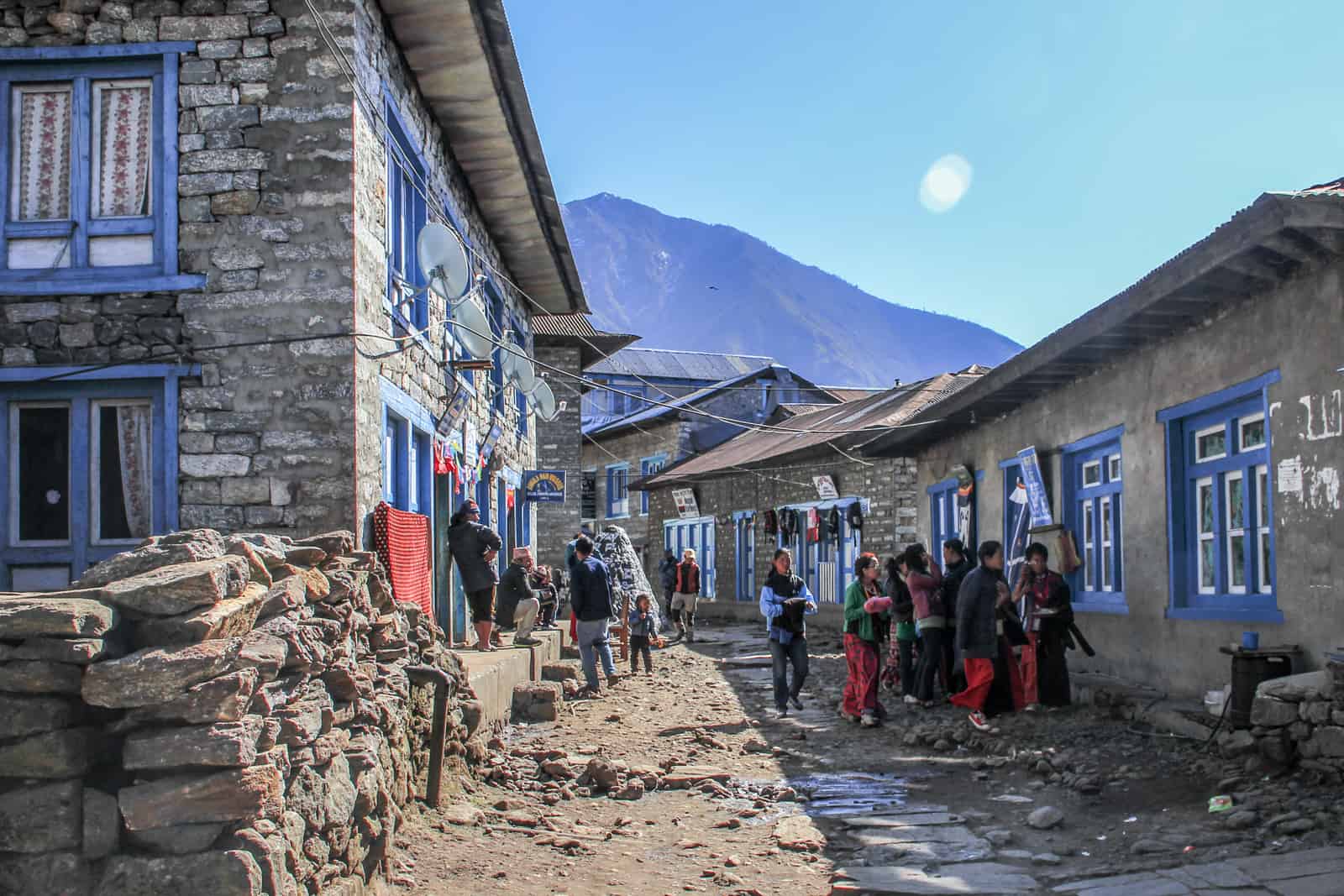
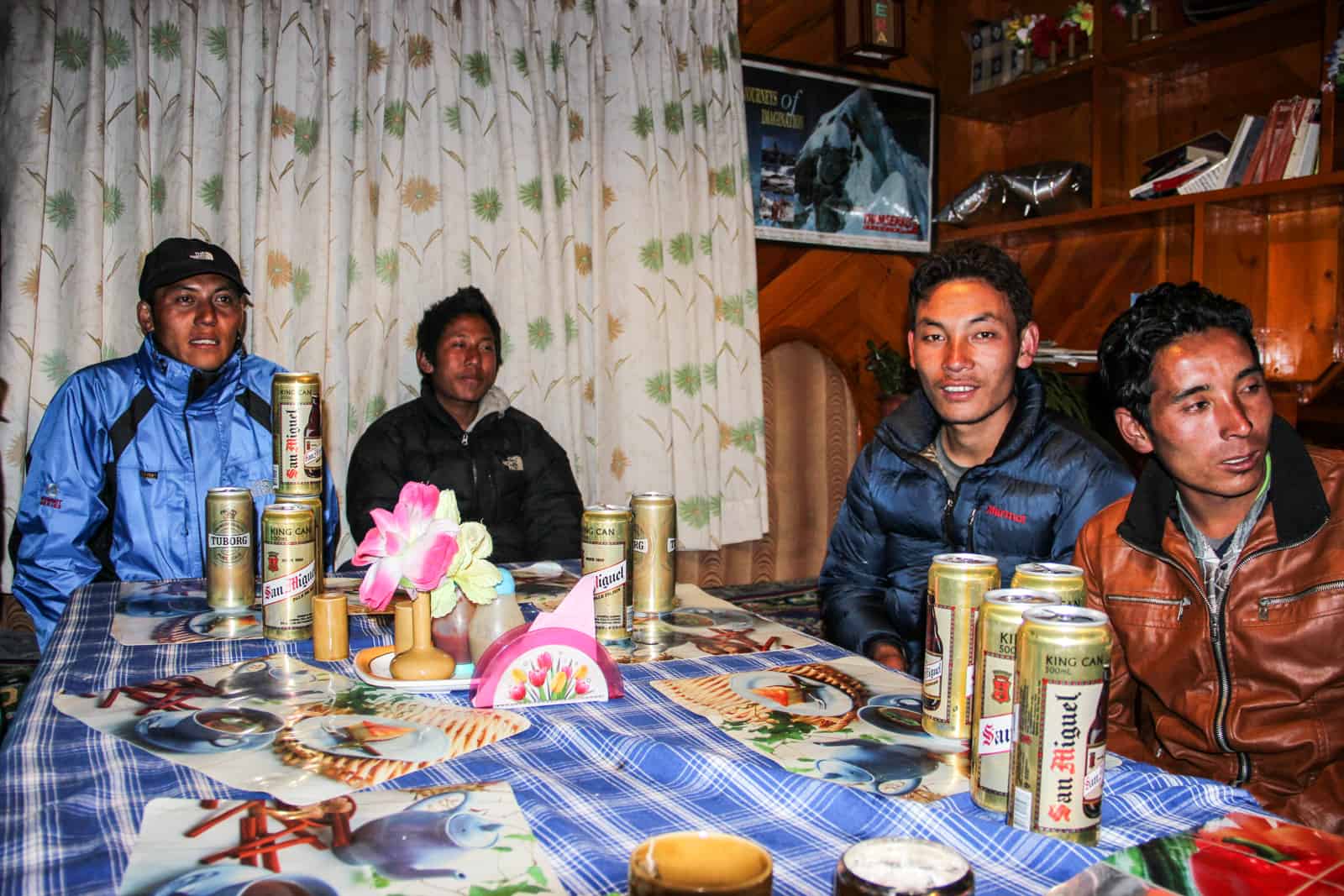
Much deserved beers for the porters
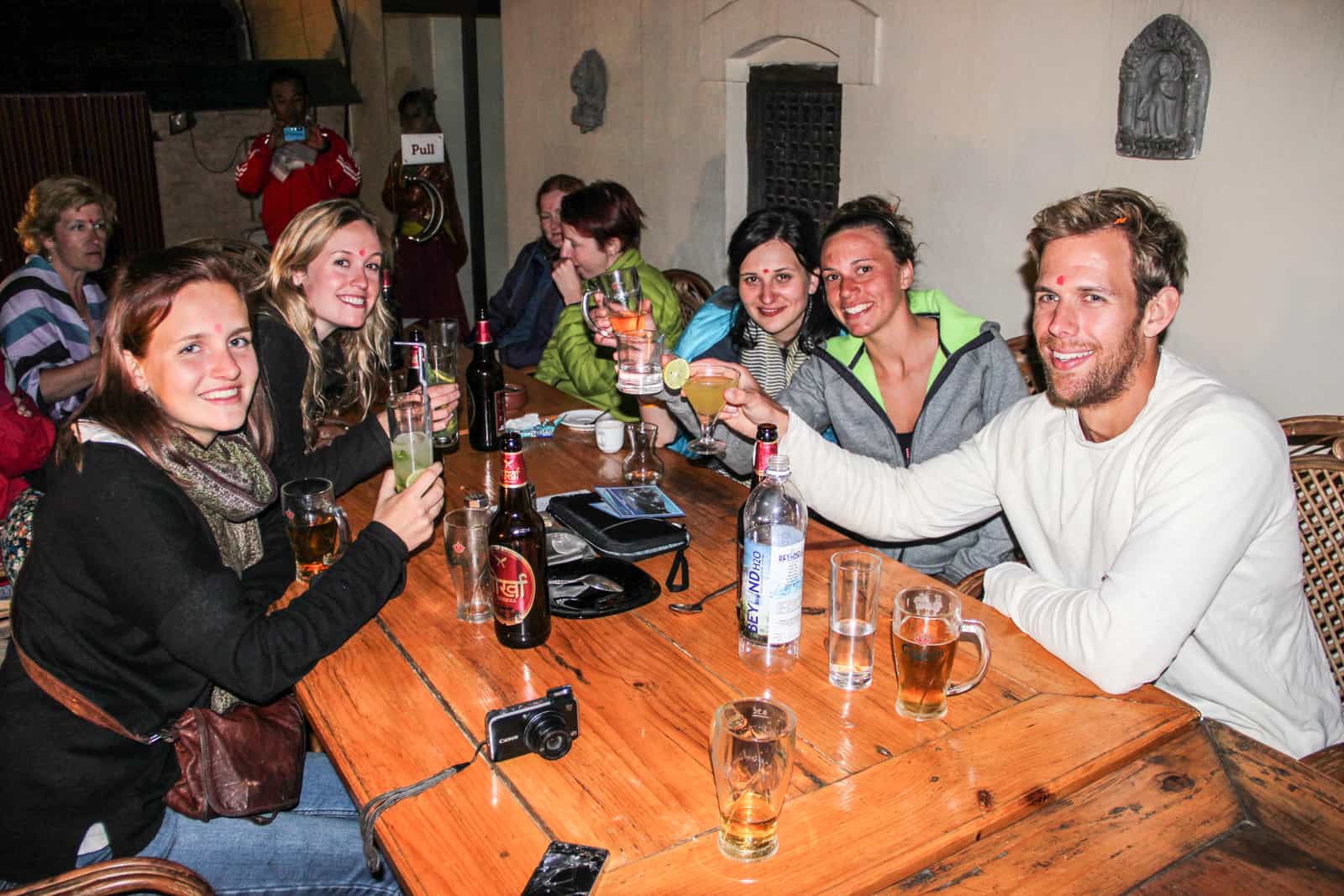
Top Tips to Complete the Trek to Everest Base Camp
Keep a Positive Mindset
The trek to Everest Base Camp is as much a test of mental agility as it is about physical strength. Despite feeling exhausted most of the time, look around you. Trekking with the magnificent High Himalayas around you, including Ama Dablam, Mount Pumori, Lhotse and Nuptse and the snow-capped misty peak of Mount Everest, you will feel as though you have been thrown into the most beautiful mountainous valley, with a 360 view of the best scenery on the planet.
Approach each climb, knowing that there’s a viewpoint so spectacular at the end that every excruciating last step is worth it. It really is.
Try to accept the uncomfortable nights in the teahouses, where your room will be made from plywood walls and the water will be ice-cold. It’s hard, and not a single night feels like a luxury. I hired a -20 sleeping bag from Kathmandu, used a silk sleeping liner, and wore as many layers as necessary. When I came across the opportunity for a hot shower, I took it, despite the cost of up to $5 for the privilege.
Do whatever it takes to make yourself feel better and try not to project too much negativity, as this can also harm the group’s morale. I found it easier to walk away from people who constantly needed to moan. Your mental stability is a crucial factor in getting you to the end goal!
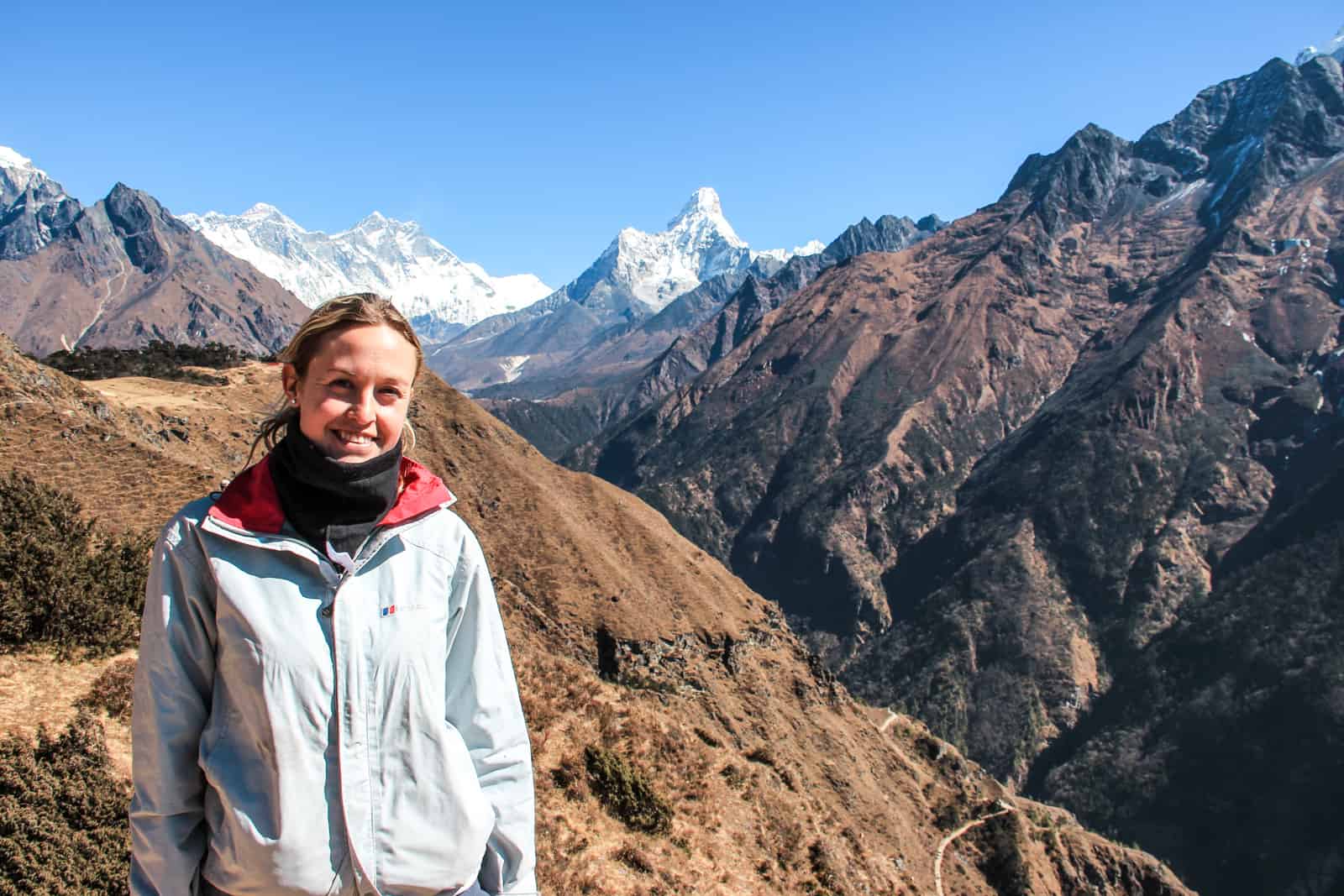
Preventing Altitude Sickness on EBC?
Aversion to altitude can be severe and result in death, but in the majority of cases, it just makes you feel extremely sick. It’s something to carefully monitor and a core vital your guides will be keeping an eye on.
Drink plenty of water
It goes without saying that it is essential to drink 2-3 litres of water each day, yet it can often be easy to forget how frequently you’ve sipped. You will be told an ideal amount of water to consume daily according to how many kilometres and hours you are trekking.
To Diamox or not to Diamox?
At the time, I chose not to take Diamox tablets as I am a migraine sufferer, and I wanted to know if my body was on shut down during the trek.
I listened to all the advice our guide gave each day regarding how much water to drink – and I drank more to ensure I stayed on top of the altitude symptoms. But, two days before reaching base camp, I succumbed to altitude sickness. I woke up in the morning with throbbing headaches, which continued while trekking. I felt nauseous and weak, and mentally I struggled, and so I took the tablets for a couple of days.
The need for Diamox varies. On the Lost City Trek in Colombia, there were no huge climbs in altitude, so it wasn’t needed. When Climbing Kilimanjaro in Tanzania, I took half a Diamox tablet in the morning and evening throughout the entire trek. If I did Everest Base Camp again, I would most likely replicate this same controlled usage of AMS medication.
Daily health check-in
Every afternoon, when we reached the teahouse, we would check our heart rate and oxygen levels with a finger pulse oximeter. Logging our vitals was a part of our daily health monitoring regarding progress or deterioration.
Go Slow
Taking slow, measured steps during the trek to Everest Base Camp is as important as staying hydrated to prevent altitude sickness. This is not a race or an opportunity to show off your sporting prowess – even the most athletic can be beaten by altitude.
Go at your own pace, and don’t be intimidated by the strength of others or feel the need to ‘keep up’. It’s better to be an hour behind and reach your goal than falter at your ruthless determination.
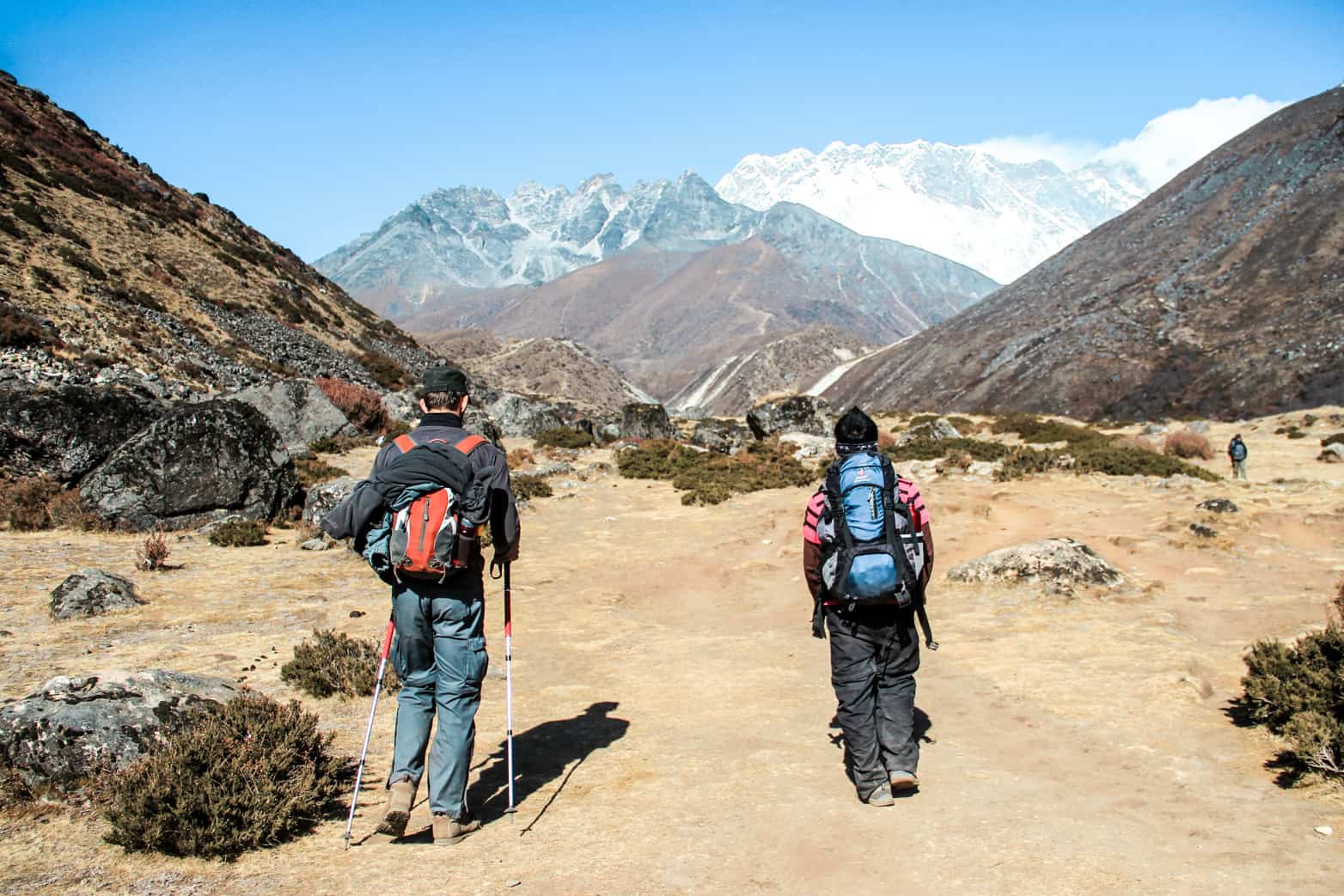
Take Plenty of Snacks and Money
I took 35,000 rupees (approx. £275) with me for the entire trek and spent it all.
For Food at the EBC Teahouses
The short and honest story is that the food on the Everest Base Camp Trek is pretty dire, especially the higher you climb. You tire of the same foods, and the bland tastes and your loss of appetite only aids the pain. Take plenty of snacks, such as protein bars and chocolate, like Snickers – a little bit of sugar helps pull you through, as does your favourite comfort foods. Or indulge in a slice of cake from the highest bakery in the world at Lobuche, despite the hefty $8+ price tag!
Food and drink become more expensive the higher you go (due to the effort required to transport it up there), with bottled water, in particular, gaining a hefty price tag. Consider using water purification tablets or a water purification filter bottle like Water-to-Go to save money.
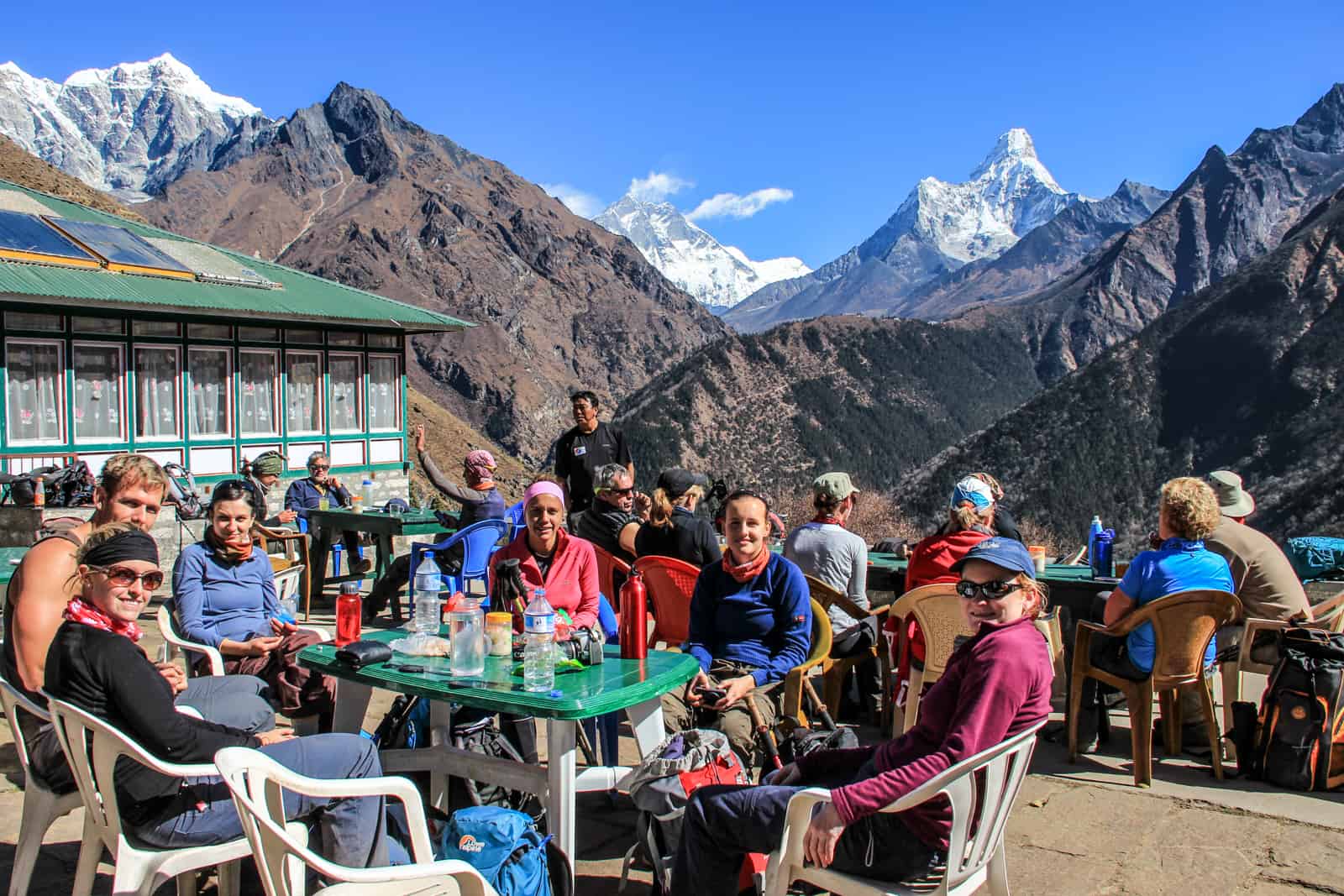
Teahouse food stop, typically halfway on the trekking route of that day
For Electricity, Showers and Wifi
Showers, access to the highest Wi-Fi connection in the world (which is sketchy at best), and battery recharging will set you back anywhere between 350-500 rupees / $5 to $10 or more. I had a local SIM card from Kathmandu, but the data only works for a few days since reception quickly fades, especially around the 4,000-metre level.
For Tipping the Porters and Guides
You will need to carry extra to tip the porters on the climb, as you will say goodbye to most of them in Lukla on the last morning. This is normally collected as a group tip that amounts to around $5 per day, per person – around $50-$60 altogether.
Keep this in a waterproof and protective pouch/wallet. We tipped our main guide at our final celebratory dinner in Kathmandu.
Bring US Dollars With You
It is advised to bring US Dollars with you into the country to exchange, as ATM fees in Kathmandu and Lukla are high, and often, the ATMs don’t always work. The last thing you want to do is withdraw money multiple times with multiple fees for a big trip like this. Bring this large sum of pocket money with you so you are ready to begin the trek with minimal stress and adequate supplies.
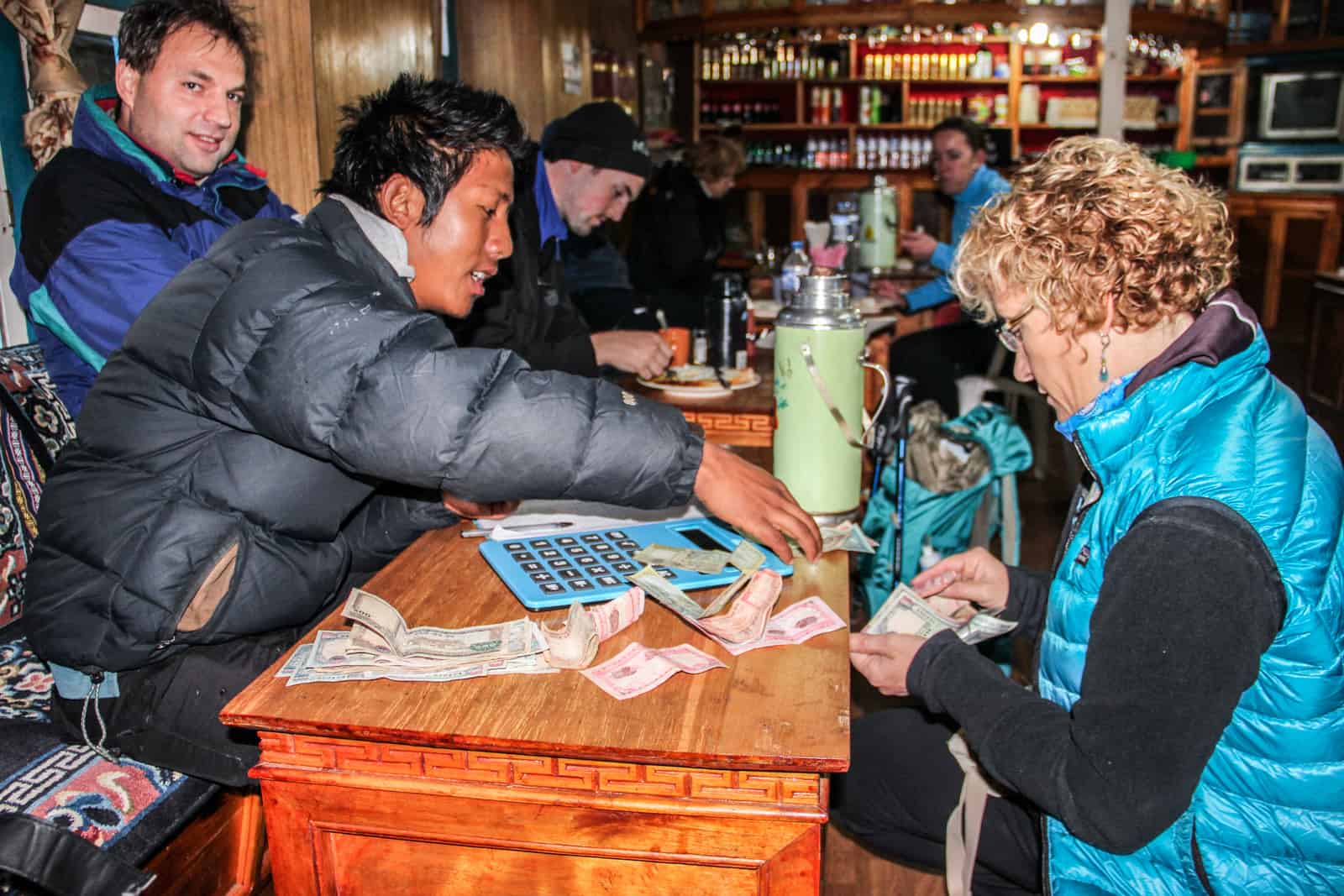
Preparing and Packing for Everest Base Camp Trekking
- Braving minus temperatures can be gruelling, especially at night. You can hire a four seasons sleeping bag (or simply ask for a -20) and a down jacket from a whole host of trekking shops in Kathmandu – these two items became my lifeline to a good night’s sleep.
- Good fitting and already broken-in trekking shoes. I bought my trekking shoes at home to wear them in before the adventure started and purchased walking poles in Kathmandu, which came in extra handy on the steeper parts of the climb.
- Walking Sticks. I don’t usually use walking poles on a long trek but for Everest Base Camp walking sticks were invaluable, especially on parts of the track where the soil was dusty and rocky and therefore more slippery.
- Do I need to bring enough toilet paper for the entire trek? No. There’s no need to pack a few toilet rolls, and it’s essential to save as much space as possible in your backpack. Bring one roll or a flat packet of soft tissues as a start, since toilet paper is easy to purchase along the way and not too expensive.
The rest is down to the art of layering:
- Thermal long-sleeved top and thermal leggings for when it gets colder at a higher altitude, and you can use them as a base layer.
- Comfortable trekking trousers. I had the ones with the zip-off leg compartment as the first and last days can see a bit of sun and warm temperatures. Don’t buy trekking pants that are too tight, as you will need space for layering, especially later into the trek.
- Three to four t-shirts and a fleece – the simple items for layering and easy removal.
- Gore-Tex and/or windproof jackets – for wind chill and an extra layer over your down jacket.
- Hat, scarf, and gloves. Insulated gloves. Remember, it’s better to be too warm than suffer the cold through lack of proper clothing.
- Underwear: Enough to last as there is no laundry service, nor will you be anywhere long enough to do laundry.
Packing Tips
- Practice packing before you leave to ensure you won’t be in a panic in the hotel room the night before.
- Don’t leave purchasing the most important gear until you get to Kathmandu. By this, I mean insulated items like thermals, a down jacket and comfortable hiking boots. Shopping in Kathmandu poses a risk – you have to sift through a lot of low-quality or fake gear, and these are things that are essential to try and test ahead of time.
- Practice carrying your daypack with you on the pre-hike warmups at home. That way, you will also train yourself to carry your clothing and other essentials and at least two litres of water on top!
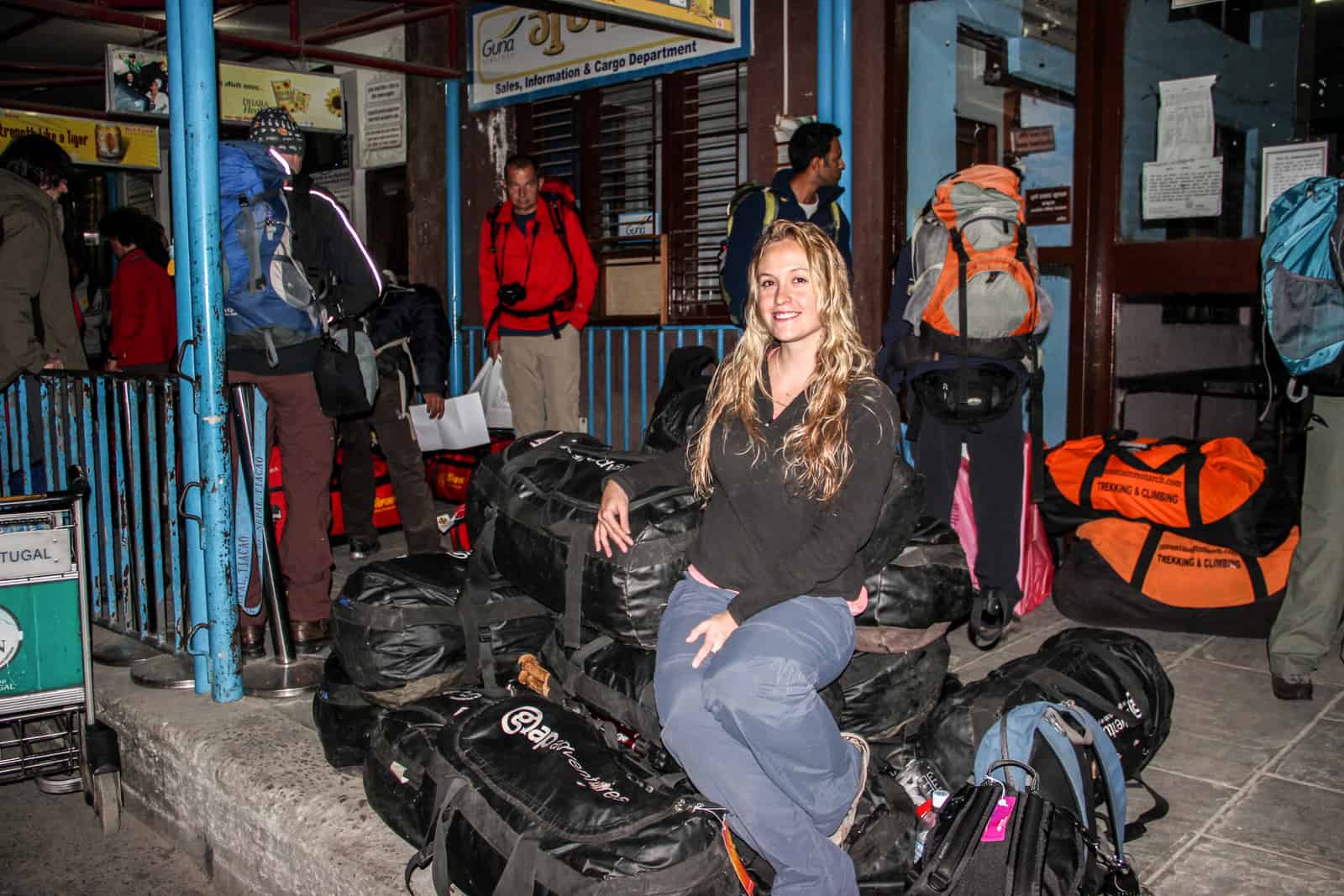
This is the bag the porters will carry during the Everest Base Camp trek.
What Travel Insurance to get for Everest Base Camp Trek
Getting travel insurance that includes trekking to a high altitude is crucial. More specifically, you must have a travel insurance policy that covers the usual, such as loss, damage, in-patient medical treatment and repatriation, but also includes mountain ascents and mountain rescue.
Check the fine print since many policies state a mountain pass limit, commonly “up to 2,500 metres” or “under 5,000m”. You may need a separate insurance policy or an activity/sports add-on that includes ‘trekking up to 6,000 metres.
For trekking EBC, you will need an insurance policy that covers:
- Treks up to the height of at least 6,000m.
- Mountain Rescue by Helicopter/helicopter evacuation.
Thinking About Trekking to Everest Base Camp? Do it!
Reaching Everest Base Camp isn’t just a light-hearted trek. It’s a mini-expedition that will test you in more ways than one.
But in that period of time, all of the pain completely disappears, leaving you to revel in what will become one of the greatest achievements of your life.
Between the pats on the back, the hugs and the handshakes of congratulations, you’ll lose yourself in complete silence as you marvel at the spectre before you – the top of the world. Not many people can say they stood over halfway towards that.
And if you don’t make it that far, you will still have traversed one of the most beautiful trekking routes on the planet.
Everest Base Camp Trek: Snapshot
Book yourself on a small adventure group to trek Nepal
- I booked the 15-day G Adventures Kathmandu to Base Camp small group tour, which includes the 12-day trek and time to explore Kathmandu either side. This cost includes the flight to Lukla, all accommodations and sherpas.
- Travel to and from Kathmandu at the start and end of the trip, and all food and drink costs during the trip are not included.
Trekking route:
- Way up: Kathmandu – Lukla – Phakding – Namche Bazaar – Tengboche – Dingboche – Lobuche – Gorak Shep.
- Way down: Pheriche – Kengjuma – Monjo – Lukla – Kathmandu
Budget:
- You should budget around £300 for food, drink and souvenirs on top of the trek cost.
Pack:
- Four Seasons sleeping bag, trekking boots, down jacket, windproof jacket, four t-shirts, one pair of trekking pants, thermal layers, a fleece and a hat, scarf and gloves
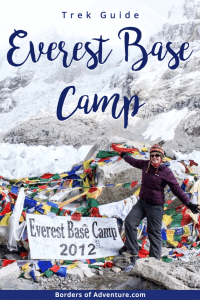
Constantly updated with the help of authorised tour guides on the ground, alongside access to regular tourism updates via tourism groups and businesses, it ensures that this article remains one of the most comprehensive on the web. Any plagiarism of this Everest Base Camp Trek blog or any of its descriptions used on other sites and blogs without attribution is not information authorised by myself for use. Know your source.
The post Everest Base Camp Trek, Nepal – A Guide to Reach the Top of the World appeared first on Borders Of Adventure.




![Climbing Mount Kinabalu – The Ultimate Trekking Guide [2025]](https://som2nynetwork.com/wp-content/plugins/phastpress/phast.php/c2VydmljZT1pbWF/nZXMmc3JjPWh0dHBzJTNBJTJGJTJGc29tMm55bmV0d29yay5jb20lMkZ3cC1jb250ZW50JTJGdXBsb2FkcyUyRjIwMjUlMkYwNyUyRk1vdW50LUtpbmFiYWx1LUNsaW1iLVRyZWstR3VpZGUtRmVhdHVyZWQtSW1hZ2UtMzM2eDIyMC5qcGcmY2FjaGVNYXJrZXI9MTc1MzAxODY3NS0xMzQxMSZ0b2tlbj1jOTRiYmYyY2U2NTczZmJm.q.jpg)

